Marine Renewable Energy in the Mediterranean Sea: Status and Perspectives
Abstract
Key Topics
- Global status of the different types of marine renewable energy (MRE), i.e., offshore wind, wave, tidal, thermal, and salinity gradients energy conversion:
- ○
- global estimates of available resources
- ○
- relevant technologies
- ○
- potential synergies;
- Main characteristics of the Mediterranean basin:
- ○
- geomorphological features
- ○
- wind and wave climate
- ○
- ecological and oceanographic characteristics
- ○
- important economic sectors associated with MRE development;
- Current energy status and future scenarios for the Mediterranean European Union (EU) member states;
- Current status, potential problems, challenges, and perspectives of MRE development in the Mediterranean Sea (MS):
- ○
- key issues of the geotechnical/engineering framework: MRE potential, distance from shore, electricity infrastructure, technology development, grid availability, intermittency, energy transmission, and energy storage
- ○
- key issues of the socio-economic framework: economics of MRE, legal and regulatory framework, employment opportunities, different uses of the marine space (tourism and visual disturbance, maritime transport, fisheries and aquaculture, marine mineral resources), finance and markets, and administrative and socio-economic constraints
- ○
- key issues of the environmental/ecological framework: environmental impacts, Marine Protected Areas, Environmental Impact Assessment studies
- ○
- necessity for Marine Spatial Planning;
- A roadmap for the sustainable development of MRE in the MS:
- ○
- recommendations and guidelines involving technical, environmental, and socio-economic aspects.
1. Introduction
- Offshore (marine) wind energy, i.e., the energy that can be harvested from the marine wind, and;
- Ocean Energy (OE), i.e., the energy that can be harvested from the ocean. Ocean energy can also be referred to as ‘Blue Energy’ and ‘renewable energy from the ocean’, and is divided into four types according to the origin of the extracted power, namely sea surface waves, tidal/sea currents, and thermal and salinity gradients; see also [1,2].
2. Global Status of Marine Renewable Energy
2.1. Offshore Wind Energy
Technology
2.2. Wave Energy
2.2.1. Technology
2.2.2. Synergies with Offshore Wind
2.3. Tidal Energy
Technology
2.4. Thermal and Salinity Gradients Energy Conversion
2.4.1. Ocean Thermal Energy Conversion
2.4.2. Salinity Gradient Energy
3. The Mediterranean Basin at a Glance
3.1. Geomorphological Characteristics
3.2. Wind and Wave Climate
3.3. Ecological Characteristics
3.4. Oceanographic Characteristics
3.5. Relevant Economic Activities
3.5.1. Tourism
3.5.2. Fisheries, Aquaculture, and Fish Farming
3.5.3. Maritime Transport
3.6. Energy Status and Scenarios
4. Marine Renewable Energy Status and Aspects in the Mediterranean Sea
4.1. Interweaving Different Viewpoints for MRE Development
4.1.1. Geotechnical/Engineering, Socio-Economic, and Environmental/Ecological Frameworks
4.1.2. Intermittency of MRE, Energy Transmission, and Storage
4.2. Ocean Energy Potential
4.2.1. Offshore Wind Energy
Offshore Wind Resource Availability
- satellite data from the BSW product of NOAA with a 6-h sampling frequency, spatial resolution of 0.25 × 0.25, and time period of 17 years (1995–2011) [150];
- ERA-Interim reanalysis data, with a 6-h sampling frequency, spatial resolution of 0.25 × 0.25, and time period of 33 years (1979–2011) [151] and
- numerical results obtained from the ETA-based atmospheric model with a 3-h sampling frequency, spatial resolution of 0.1 × 0.1, and a time period of 15 years (1995–2009) [105].
Status of Offshore Wind Energy Development
4.2.2. Wave Energy
Status of Wave Energy Development
4.2.3. Tidal/Current Energy
4.2.4. Salinity and Thermal Gradients Energy
4.3. Key Technical Considerations for MRE Development
4.3.1. Bathymetry and Distance to Shore
4.3.2. Electricity Infrastructure
4.4. Environmental Considerations
4.4.1. Potential Environmental Impacts
4.4.2. Marine Protected Areas
4.4.3. Environmental Impact Assessment Studies
4.5. Socio-Economic Considerations
4.5.1. The Economics of Offshore Renewables
4.5.2. Legal and Regulatory Framework
4.5.3. Employment Opportunities
4.5.4. Struggling for Space?
Tourism and Visual Disturbance
Maritime Transport
Fisheries and Aquaculture
Marine Mineral Resources
4.5.5. The Necessity of Marine Spatial Planning
5. A Roadmap for MRE Development in the Mediterranean Sea
5.1. General
5.2. Technical Recommendations
5.3. Environmental Recommendations
5.4. Socio-Economic Recommendations
- Combining other beneficial economic activities with the operation of MRE plants (e.g., the underwater structures of WTs or other MRE devices can be used to farm filtering bivalves or provide space for commercial fish, mimicking artificial reefs) in order to minimize fears and prejudices. These activities might become part of the compensations offered to the local communities.
- Raising environmental awareness of the local communities through informational campaigns and by making explicit the pros and cons of each MRE plant; the advantages for the local communities must be realistically stated, along with proposed compensation measures.
- Providing proper and accurate information of stakeholders about the economic implications of MRE installations on tourism.
- Performing detailed socio-economic valuation surveys during the design phase of MRE projects, with consultation processes for any relevant application, focusing on stakeholders.
5.5. Roadmap Summary
- Perform in situ metocean measurements and acquire long-term simulation results from numerical models of high spatial resolution, especially in the nearshore/coastal areas
- Simulate the potential impacts of MRE installations on the local geophysical/oceanographic characteristics
- Acquire detailed information on the environmentally sensitive marine areas and habitats at depths 0–200 m
- Map bird migration routes to facilitate the development of offshore wind sector
- Screen and map the existing habitats and the distributions of important species
- Design and implementation of monitoring campaigns before and during construction, operation, and decommissioning of MRE installations.
- Invest in the development of new technologies or adapt existing ones in order to provide tailor-made solutions for MRE exploitation in an economically viable way
- Support onshore wave devices as a rational solution for the already existing infrastructure
- Consider synergy of offshore wind and wave energy at carefully selected sites
- Promote offshore wind energy that is mature to meet the requirements for commercial development
- Promote floating structures as a rational solution for offshore wind exploitation and as a measure to mitigate potential environmental effects.
- Perform EIA studies of actual and realistic value followed by consultation of the general public, local authorities, organizations concerned, and any stakeholder involved in the MRE project
- Review and share the knowledge from the implementation of important EU directives for enabling more consistent approaches across Mediterranean EU Member States, especially in cross-border cooperation issues
- Increase the likelihood of social acceptance for MRE development by several means (combining other beneficial economic activities with the operation of MRE plants, raising environmental awareness of the local communities through informational campaigns, providing proper and accurate information of stakeholders about the economic implications of MRE installations on tourism, performing detailed socio-economic valuation surveys during the design phase of MRE projects focusing on stakeholders).
- Develop MSP and ICZM at the regional/local level for establishing a holistic management of marine, maritime, and coastal activities in the ocean space
- Strengthen financial stability, application of effective financing tools, governance support, enhancing and centralizing of permitting bodies’ capacity, rationalization, and simplification of licensing and permitting procedures, improvement of policy frameworks
- Revise (if necessary) national policies and environmental, socio-economic, technical, and legislative considerations
- Harmonize and integrate national, regional, and transnational policies (at least for the EU Member States) in order to mitigate the problem of conflicting regulations and legislations.
- Learn from both positive and negative experience and examples at the global level.
Acknowledgments
Author contributions
Conflicts of Interest
Abbreviations-Acronyms
| AIS | Automatic Identification System |
| BE | Blue Energy |
| BSW | Blended Sea Winds |
| CAPEX | Capital expenditures |
| CS | Conservative Scenario |
| ECMWF | European Center for Medium-Range Weather Forecasts |
| EEZ | Exclusive Economic Zone |
| EIA | Environmental Impact Assessment |
| ELEMED | Electrification of the Eastern Mediterranean Area |
| EMEC | European Marine Energy Center |
| EMF | Electromagnetic field |
| ENTSO-E | European Network of Transmission System Operators for Electricity |
| EU | European Union |
| EWEA | European Wind Energy Association. |
| FEAP | Federation of European Aquaculture Producers |
| FiP | Feed-in premium |
| FiT | Feed-in tariff |
| GFCM | General Fisheries Commission for the Mediterranean |
| HCMR | Hellenic Center for Marine Research |
| ICZM | Integrated Coastal Zone Management |
| IPCC | Intergovernmental Panel on Climate Change |
| ISWEC | Inertial Sea Wave Energy Converter |
| ITTC | International Towing Tank Conference |
| LCOE | Levelized cost of energy |
| MPA | Marine protected Area |
| MRE | Marine Renewable Energy |
| MS | Mediterranean Sea |
| MSP | Marine Spatial Planning |
| Mtoe | Million tonnes oil equivalent |
| MUP | Multi-use offshore platforms |
| NIMBY | Not in my backyard |
| NOAA | National Oceanic and Atmospheric Administration |
| O&M | Operation and Maintenance |
| OBREC | Overtopping BReakwater for wave Energy Conversion |
| OE | Ocean Energy |
| OHI | Ocean Health Index |
| OPEX | Operational expenditures |
| OTEC | Ocean thermal energy conversion |
| OWF | Offshore wind farm |
| QuikSCAT | Quick Scatterometer |
| R&D | Research and Development |
| RAC/SPA | Regional Activity Center for Specially Protected Areas |
| RES | Renewable energy sources |
| TEC | Tidal-stream Energy Converter |
| TS | Energy Transition Scenario |
| TWh | Terawatt-hour |
| WEC | Wave Energy Converter |
| WT | Wind turbine |
References
- Borthwick, A.G.L. Marine Renewable Energy Seascape. Engineering 2016, 2, 69–78. [Google Scholar] [CrossRef]
- European Commission. Communication from the Commission to the European Parliament, the Council, the European Economic and Social Committee and the Committee of the Regions: Blue Energy Action Needed to Deliver on the Potential of Ocean Energy in European Seas and Oceans by 2020 and Beyond; European Commission: Brussels, Belgium, 2014; p. 11. Available online: http://eur-lex.europa.eu/legal-content/EN/TXT/PDF/?uri=CELEX:52014DC0008&from=EN (accessed on 16 May 2017).
- Appiott, J.; Dhanju, A.; Cicin-Sain, B. Encouraging Renewable Energy in the Offshore Environment. Ocean Coast. Manag. 2014, 90, 58–64. [Google Scholar] [CrossRef]
- Global Wind Energy Council. Global Wind Report 2016—Annual Market Update; Global Wind Energy Council: Brussels, Belgium, 2016; p. 76. Available online: http://www.gwec.net/publications/global-wind-report-2/ (accessed on 9 June 2017).
- Edenhofer, O.; Pichs-Madruga, R.; Sokona, Y.; Seyboth, K.; Kadner, S.; Zwickel, T.; Eickemeier, P.; Hansen, G.; Schlömer, S.; von Stechow, C.; et al. Renewable Energy Sources and Climate Change Mitigation: Special Report of the Intergovernmental Panel on Climate Change; Cambridge University Press: New York, NY, USA, 2011; p. 1088. [Google Scholar]
- Ocean Energy Forum. Ocean Energy Strategic Roadmap 2016, Building Ocean Energy for Europe. Available online: https://webgate.ec.europa.eu/maritimeforum/sites/maritimeforum/files/OceanEnergyForum_Roadmap_Online_Version_08Nov2016.pdf (accessed on 30 December 2016).
- Wind Europe. The European Offshore Wind Industry—Key Trends and Statistics 2016; Wind Europe: Brussels, Belgium, 2017; p. 37. [Google Scholar]
- Resch, G.; Welisch, M.; Liebmann, L.; Breitschopf, B.; Held, A. A Prospective Assessment of Costs and Benefits of Renewable energy Use in the European Union. Energy Environ. 2016, 27, 10–27. [Google Scholar] [CrossRef]
- Duscha, V.; Fougeyrollas, A.; Nathani, C.; Pfaff, M.; Ragwitz, M.; Resch, G.; Schade, W.; Breitschopf, B.; Walz, R. Renewable energy Deployment in Europe up to 2030 and the Aim of a Triple Dividend. Energy Policy 2016, 95, 314–323. [Google Scholar] [CrossRef]
- Magagna, D.; Uihlein, A. Ocean Energy Development in Europe: Current Status and Future Perspectives. Int. J. Mar. Energy 2015, 11, 84–104. [Google Scholar] [CrossRef]
- Taveira-Pinto, F.; Iglesias, G.; Rosa-Santos, P.; Deng, Z.D. Preface to Special Topic: Marine Renewable Energy. J. Renew. Sustain. Energy 2015, 7, 061601. [Google Scholar] [CrossRef]
- Manwell, J. Offshore Wind Energy Technology Trends, Challenges and Risks. In Renewable Energy Systems; Kaltschmitt, M.T.N.J., Bronicki, L.Y., Söder, L., Vega, L.A., Eds.; Springer: New York, NY, USA, 2013; pp. 1306–1338. [Google Scholar]
- Soukissian, T. Use of Multi-parameter Distributions for Offshore Wind Speed Modeling: The Johnson SB Distribution. Appl. Energy 2013, 111, 982–1000. [Google Scholar] [CrossRef]
- Zheng, C.W.; Pan, J. Assessment of the Global Ocean Wind Energy Resource. Renew. Sustain. Energy Rev. 2014, 33, 382–391. [Google Scholar] [CrossRef]
- Zheng, C.; Li, C.; Gao, C.; Liu, M. A Seasonal Grade Division of the Global Offshore Wind Energy Resource. Acta Oceanol. Sin. 2017, 36, 109–114. [Google Scholar] [CrossRef]
- Capps, S.B.; Zender, C.S. Estimated Global Ocean Wind Power Potential from QuikSCAT observations, Accounting for Turbine Characteristics and Siting. J. Geophys. Res.-Atmos. 2010, 115. [Google Scholar] [CrossRef]
- Zheng, C.W.; Li, C.Y.; Pan, J.; Liu, M.Y.; Xia, L.L. An Overview of Global Ocean Wind Energy Resource Evaluations. Renew. Sustain. Energy Rev. 2016, 53, 1240–1251. [Google Scholar] [CrossRef]
- Observatoire Méditerranéen de l’Energie. Global Energy for the Mediterranean, Special: COP22 ed.; Observatoire Méditerranéen de l’Energie: Paris, France, 2016; Volume 25. [Google Scholar]
- Musial, W.; Ram, B. Large-Scale Offshore Wind Power in the United States: Assessment of Opportunities and Barriers; National Renewable Energy Laboratory: Golden, CO, USA, 2010; p. 240. Available online: http://www.nrel.gov/docs/fy10osti/40745.pdf (accessed on 5 November 2016).
- International Energy Agency. Technology Roadmap—Wind Energy; International Energy Agency: Paris, France, 2013; p. 58. Available online: https://www.iea.org/publications/freepublications/publication/Wind_2013_Roadmap.pdf (accessed on 5 November 2016).
- Arshad, M.; O’Kelly, B.C. Offshore Wind-turbine Structures: A review. Proc. Inst. Civ. Eng.-Energy 2013, 166, 139–152. [Google Scholar] [CrossRef]
- Kumar, Y.; Ringenberg, J.; Depuru, S.S.; Devabhaktuni, V.K.; Lee, J.W.; Nikolaidis, E.; Andersen, B.; Afjeh, A. Wind Energy: Trends and Enabling Technologies. Renew. Sustain. Energy Rev. 2016, 53, 209–224. [Google Scholar] [CrossRef]
- International Renewable Energy Agency. Innovation Outlook: Offshore Wind; International Renewable Energy Agency: Abu Dhabi, UAE, 2016; p. 160. [Google Scholar]
- Borg, M.; Collu, M.; Kolios, A. Offshore Floating Vertical Axis Wind Turbines, Dynamics Modelling State of the Art. Part II: Mooring Line and Structural Dynamics. Renew. Sustain. Energy Rev. 2014, 39, 1226–1234. [Google Scholar] [CrossRef]
- Floating Wind Turbine. Available online: https://en.wikipedia.org/wiki/Floating_wind_turbine (accessed on 30 July 2017).
- James, R.; Ros, M. Floating Offshore Wind: Market and Technology Review; Carbon Trust: UK, 2015; p. 168.
- European Wind Energy Association. The European Offshore Wind Industry—Key Trends and Statistics 2015; European Wind Energy Association: Brussels, Belgium, 2016; p. 24. Available online: https://www.ewea.org/fileadmin/files/library/publications/statistics/EWEA-European-Offshore-Statistics-2015.pdf (accessed on 5 April 2017).
- Cruz, J.; Atcheson, M. Floating Offshore Wind Energy. The Next Generation of Wind Energy; Springer International Publishing: Cham, Switzerland, 2016; p. 341. [Google Scholar]
- Castro-Santos, L.; Diaz-Casas, V. Floating Offshore Wind Farms; Springer International Publishing: Cham, Switzerland, 2016; p. 193. [Google Scholar]
- Floating Wind Energy—World Map 2017. Available online: http://www.floating-wind-energy.nl/ (accessed on 1 September 2017).
- European Wind Energy Association. Offshore Wind in Europe-Walking the Tightrope to Success; European Wind Energy Association: Brussels, Belgium, 2015. [Google Scholar]
- McKenna, R.; von der Leye, P.O.; Fichtner, W. Key Challenges and Prospects for Large Wind Turbines. Renew. Sustain. Energy Rev. 2016, 53, 1212–1221. [Google Scholar] [CrossRef]
- Clement, A.; McCullen, P.; Falcao, A.; Fiorentino, A.; Gardner, F.; Hammarlund, K.; Lemonis, G.; Lewis, T.; Nielsen, K.; Petroncini, S.; et al. Wave Energy in Europe: Current Status and Perspectives. Renew. Sustain. Energy Rev. 2002, 6, 405–431. [Google Scholar] [CrossRef]
- Falnes, J. A Review of Wave-energy Extraction. Mar. Struct. 2007, 20, 185–201. [Google Scholar] [CrossRef]
- Falcao, A.F.D. Wave Energy Utilization: A Review of the Technologies. Renew. Sustain. Energy Rev. 2010, 14, 899–918. [Google Scholar] [CrossRef]
- International Renewable Energy Agency. Wave Energy Technology Brief; International Renewable Energy Agency: Abu Dhabi, UAE, 2014; p. 28. Available online: http://www.irena.org/DocumentDownloads/Publications/Wave-Energy_V4_web.pdf (accessed on 5 April 2017).
- Moørk, G.; Barstow, S.; Kabuth, A.; Pontes, M.T. Assessing the Global Wave Energy Potential. In Proceedings of the 29th International Conference on Ocean, Offshore Mechanics and Arctic Engineering, Shanghai, China, 6–11 June 2010; pp. 447–454. [Google Scholar]
- Reguero, B.G.; Losada, I.J.; Mendez, F.J. A Global Wave Power Resource and its Seasonal, Interannual and Long-term Variability. Appl. Energy 2015, 148, 366–380. [Google Scholar] [CrossRef]
- Arinaga, R.A.; Cheung, K.F. Atlas of Global Wave Energy from 10 years of Reanalysis and Hindcast Data. Renew. Energy 2012, 39, 49–64. [Google Scholar] [CrossRef]
- Pecher, A.; Kofoed, J.P. Handbook of Ocean Wave Energy; Springer International Publishing: Berlin, Germay, 2017; Volume 7. [Google Scholar]
- Gunn, K.; Stock-Williams, C. Quantifying the Global Wave Power Resource. Renew. Energy 2012, 44, 296–304. [Google Scholar] [CrossRef]
- Archimedes Waveswing Submerged Wave Power Buoy. Available online: http://www.awsocean.com/archimedes-waveswing.html (accessed on 1 September 2017).
- Wave Energy Module Successfully Installed on Crete for the First Time. Available online: https://www.sinnpower.com/single-post/2015/12/16/Wave-energy-module-successfully-installed-on-Crete-for-the-first-time (accessed on 30 July 2017).
- List of Wave Power Projects. Available online: https://en.wikipedia.org/wiki/List_of_wave_power_projects (accessed on 30 July 2017).
- Lopez, I.; Andreu, J.; Ceballos, S.; de Alegria, I.M.; Kortabarria, I. Review of Wave Energy Technologies and the Necessary Power-equipment. Renew. Sustain. Energy Rev. 2013, 27, 413–434. [Google Scholar] [CrossRef]
- Day, A.H.; Babarit, A.; Fontaine, A.; He, Y.P.; Kraskowski, M.; Murai, M.; Penesis, I.; Salvatore, F.; Shin, H.K. Hydrodynamic Modelling of Marine Renewable Energy Devices: A State of the Art Review. Ocean Eng. 2015, 108, 46–69. [Google Scholar] [CrossRef]
- Bahaj, A.S. Generating Electricity from the Oceans. Renew. Sustain. Energy Rev. 2011, 15, 3399–3416. [Google Scholar] [CrossRef]
- Titah-Benbouzid, H.; Benbouzid, M. Ocean Wave Energy Extraction: Up-to-Date Technologies Review and Evaluation. In Proceedings of the 2014 IEEE International Power Electronics and Application Conference and Exposition (PEAC), Shanghai, China, 5–8 November 2014; pp. 338–342. [Google Scholar]
- Soukissian, T.H. Probabilistic Modeling of Directional and Linear Characteristics of Wind and Sea States. Ocean Eng. 2014, 91, 91–110. [Google Scholar] [CrossRef]
- Pelamis Wave Power. Available online: http://www.emec.org.uk/about-us/wave-clients/pelamis-wave-power/ (accessed on 1 September 2017).
- Water Powder & DAM Construction. Available online: http://www.waterpowermagazine.com/features/featurecoastal-conversions/featurecoastal-conversions-5.html (accessed on 30 July 2017).
- Available online: http://oceanenergy.ie/platform/ (accessed on 1 September 2017).
- Falcão, A.F.O.; Henriques, J.C.C. Oscillating-water-column Wave Energy Converters and Air Turbines: A Review. Renew. Energy 2016, 85, 1391–1424. [Google Scholar] [CrossRef]
- Wave Dragon. Available online: http://www.wavedragon.net/index.php?option=com_frontpage&Itemid=1 (accessed on 30 July 2017).
- Sgobbi, A.; Simoes, S.G.; Magagna, D.; Nijs, W. Assessing the Impacts of Technology Improvements on the Deployment of Marine Energy in Europe with an Energy System Perspective. Renew. Energy 2016, 89, 515–525. [Google Scholar] [CrossRef]
- Nambiar, A.J.; Collin, A.J.; Karatzounis, S.; Rea, J.; Whitby, B.; Jeffrey, H.; Kiprakis, A.E. Optimising Power Transmission Options for Marine Energy Converter Farms. Int. J. Mar. Energy 2016, 15, 127–139. [Google Scholar] [CrossRef]
- Thorburn, K.; Bernhoff, H.; Leijon, M. Wave Energy Transmission System Concepts for Linear Generator Arrays. Ocean Eng. 2004, 31, 1339–1349. [Google Scholar] [CrossRef]
- O’Hagan, A.M.; Huertas, C.; O’Callaghan, J.; Greaves, D. Wave Energy in Europe: Views on Experiences and Progress to Date. Int. J. Mar. Energy 2016, 14, 180–197. [Google Scholar] [CrossRef]
- Astariz, S.; Iglesias, G. The Economics of Wave Energy: A review. Renew. Sustain. Energy Rev. 2015, 45, 397–408. [Google Scholar] [CrossRef]
- Astariz, S.; Vazquez, A.; Iglesias, G. Evaluation and Comparison of the Levelized Cost of Tidal, Wave, and Offshore Wind Energy. J. Renew. Sustain Energy 2015, 7, 053112. [Google Scholar] [CrossRef]
- Perez-Collazo, C.; Greaves, D.; Iglesias, G. A Review of Combined Wave and Offshore Wind Energy. Renew. Sustain. Energy Rev. 2015, 42, 141–153. [Google Scholar] [CrossRef]
- Ringwood, J.V.; Simani, S. Overview of Modelling and Control Strategies for Wind Turbines and Wave Energy Devices: Comparisons and Contrasts. Annu. Rev. Control 2015, 40, 27–49. [Google Scholar] [CrossRef]
- Ding, S.; Yan, S.; Han, D.; Ma, Q. Overview on Hybrid Wind–wave Energy Systems. In International Conference on Applied Science and Engineering Innovation; Atlantis Press: Amsterdam, The Netherlands, 2015; pp. 502–507. [Google Scholar]
- Available online: http://www.floatingpowerplant.com/ (accessed on 24 August 2017).
- Kim, K.-H.; Lee, K.; Sohn, J.M.; Park, S.-W.; Choi, J.-S.; Hong, K. Conceptual Design of 10MW Class Floating Wave-Offshore Wind Hybrid Power Generation System. In Proceedings of the Twenty-Fifth International Ocean and Polar Engineering (ISOPE) Conference, Kona, HI, USA, 21–26 June 2015; p. 7. [Google Scholar]
- Karimirad, M.; Koushan, K. WindWEC: Combining Wind and Wave Energy Inspired by Hywind and Wavestar. In Proceedings of the 2016 IEEE International Conference on Renewable Energy Research and Applications (ICRERA), Birmingham, UK, 20–23 November 2016; pp. 96–101. [Google Scholar]
- Mobilising the Total Offshore Renewable Energy Resource. Available online: http://www.pelagicpower.no/ (accessed on 25 August 2017).
- Astariz, S.; Perez-Collazo, C.; Abanades, J.; Iglesias, G. Towards the Optimal Design of a Co-located Wind-wave Farm. Energy 2015, 84, 15–24. [Google Scholar] [CrossRef]
- Astariz, S.; Perez-Collazo, C.; Abanades, J.; Iglesias, G. Hybrid Wave and Offshore Wind Farms: A Comparative Case Study of Co-located Layouts. Int. J. Mar. Energy 2016, 15, 2–16. [Google Scholar] [CrossRef]
- Astariz, S.; Iglesias, G. Selecting Optimum Locations for Co-located Wave and Wind Energy Farms. Part I: The Co-Location Feasibility Index. Energy Convers. Manag. 2016, 122, 589–598. [Google Scholar] [CrossRef]
- Astariz, S.; Iglesias, G. Selecting Optimum Locations for Co-located Wave and Wind Energy Farms. Part II: A case study. Energy Convers. Manag. 2016, 122, 599–608. [Google Scholar] [CrossRef]
- Veigas, M.; Iglesias, G. A Hybrid Wave-Wind Offshore Farm for an Island. Int. J. Green Energy 2014, 12, 570–576. [Google Scholar] [CrossRef]
- Ioannou, A.; Kalfas, A.I.; Karambas, T.V. Integrated Overtopping Wave Energy Converter in a Hybrid Offshore Wind Turbine Power Generation System. In Proceedings of the ASME Turbo Expo 2014: Turbine Technical Conference and Exposition, Düsseldorf, Germany, 16–20 June 2014. [Google Scholar]
- Castro-Santos, L.; Martins, E.; Soares, C.G. Cost Assessment Methodology for Combined Wind and Wave Floating Offshore Renewable Energy Systems. Renew. Energy 2016, 97, 866–880. [Google Scholar] [CrossRef]
- Bryden, G. Tidal Energy. In Renewable Energy Systems; Kaltschmitt, M., Themelis, N.J., Bronicki, L.Y., Söder, L., Vega, L., Eds.; Springer: New York, NY, USA, 2013; pp. 1466–1474. [Google Scholar]
- International Renewable Energy Agency. Tidal Energy Technology Brief; International Renewable Energy Agency: Abu Dhabi, UAE, 2014; p. 36. Available online: http://www.irena.org/DocumentDownloads/Publications/Tidal_Energy_V4_WEB.pdf (accessed on 2 August 2017).
- Ernst&Young. Rising Tide: Global Trends in the Emerging Ocean Energy Market; Ernst&Young: London, UK, 2013; p. 44. Available online: http://www.ey.com/Publication/vwLUAssets/EY-Ocean-energy-Rising-tide-2013/$FILE/EY-Ocean-energy-Rising-tide-2013.pdf (accessed on 2 August 2017).
- PLAT-O Tidal Turbines Platform up and Running. Available online: http://tidalenergytoday.com/2015/07/07/plat-o-tidal-turbines-platform-up-and-running/ (accessed on 1 September 2017).
- Tidal Project. Available online: http://www.4coffshore.com/windfarms/tidals.aspx (accessed on 1 September 2017).
- Polagye, B.; Van Cleve, B.; Copping, A.; Kirkendall, K. (Eds.) Environmental Effects of Tidal Energy Development; U.S. Department Commerce: Washington, DC, USA, 2011; p. 181.
- Rourke, F.O.; Boyle, F.; Reynolds, A. Tidal Energy Update 2009. Appl. Energy 2010, 87, 398–409. [Google Scholar] [CrossRef]
- Robins, P.E.; Neill, S.P.; Lewis, M.J.; Ward, S.L. Characterising the Spatial and Temporal Variability of the Tidal-stream Energy Resource Over the Northwest European Shelf Seas. Appl. Energy 2015, 147, 510–522. [Google Scholar] [CrossRef]
- Mérigaud, A.; Ringwood, J.V. Condition-based Maintenance Methods for Marine Renewable Energy. Renew. Sustain. Energy Rev. 2016, 66, 53–78. [Google Scholar] [CrossRef]
- Nihous, G.C. A Preliminary Assessment of Ocean Thermal Energy Conversion Resources. J. Energy Resour. ASME 2007, 129, 10–17. [Google Scholar] [CrossRef]
- Rajagopalan, K.; Nihous, G.C. Estimates of Global Ocean Thermal Energy Conversion (OTEC) Resources Using an Ocean General Circulation Model. Renew. Energy 2013, 50, 532–540. [Google Scholar] [CrossRef]
- Kim, A.S.; Kim, H.J.; Lee, H.S.; Cha, S. Dual-use Open Cycle Ocean Thermal Energy Conversion (OC-OTEC) Using Multiple Condensers for Adjustable Power Generation and Seawater Desalination. Renew. Energy 2016, 85, 344–358. [Google Scholar] [CrossRef]
- Vega, L. Ocean Thermal Energy Conversion. In Renewable Energy Systems; Kaltschmitt, M., Themelis, N., Bronicki, L., Söder, L., Vega, L., Eds.; Springer: New York, NY, USA, 2013; pp. 1273–1305. [Google Scholar]
- NEMO—10.7 MW Martinique in Development. Available online: http://www.akuoenergy.com/en/nemo (accessed on 1 September 2017).
- OTEC Projects around the World. Available online: http://www.otecnews.org/otecprojects/ (accessed on 30 July 2017).
- Ocean Thermal Energy Conversion. Available online: https://en.wikipedia.org/wiki/Ocean_thermal_energy_conversion (accessed on 30 July 2017).
- International Renewable Energy Agency. Ocean Thermal Energy Conversion Technology Brief; International Renewable Energy Agency: Abu Dhabi, UAE, 2014; p. 24. Available online: http://www.irena.org/DocumentDownloads/Publications/Ocean_Thermal_Energy_V4_web.pdf (accessed on 2 August 2017).
- Alvarez-Silva, O.; Winter, C.; Osorio, A.F. Salinity Gradient Energy at River Mouths. Environ. Sci. Technol. Lett. 2014, 1, 410–415. [Google Scholar] [CrossRef]
- International Renewable Energy Agency. Salinity Gradient Energy Technology Brief; International Renewable Energy Agency: Abu Dhabi, UAE, 2014; p. 28. Available online: http://www.irena.org/DocumentDownloads/Publications/Salinity_Energy_v4_WEB.pdf (accessed on 2 August 2017).
- Alvarez-Silva, O.A.; Osorio, A.F.; Winter, C. Practical Global Salinity Gradient Energy Potential. Renew. Sustain. Energy Rev. 2016, 60, 1387–1395. [Google Scholar] [CrossRef]
- Nijmeijer, K.; Metz, S. Salinity Gradient Energy. In Sustainability Science and Engineering; Escobar, I.C., Schäfer, A.I., Eds.; Elsevier: Amsterdam, The Netherlands, 2010; Volume 2, pp. 95–139. [Google Scholar]
- Willemse, R. Case 27: Blue Energy (Salinity Power) in The Netherlands; Report of the Project: Cultural Influences on Renewable Energy Acceptance and Tools for the Development of Communication Strategies to Promote ACCEPTANCE among Key Actor Groups. 2007; p. 19. Available online: http://www.esteem-tool.eu/fileadmin/esteem-tool/docs/CASE_27_def.pdf (accessed on 2 August 2017).
- United Nations Environment Programme (UNEP)/Mediterranean Action Plan (MAP). State of the Mediterranean Marine and Coastal Environment, UNEP/MAP—Barcelona Convention, Athens; UNEP/MAP: Adler, Russia, 2012; p. 96. [Google Scholar]
- Amblàs, D.; Canals, M.; Lastras, G.; Berné, S.; Loubrieu, B. Imaging the Seascapes of the Mediterranean. Oceanography 2004, 17, 144–155. [Google Scholar] [CrossRef]
- Anthony, E.J.; Marriner, N.; Morhange, C. Human Influence and the Changing Geomorphology of Mediterranean Deltas and Coasts over the Last 6000 Years: From Progradation to Destruction Phase? Earth-Sci. Rev. 2014, 139, 336–361. [Google Scholar] [CrossRef]
- Coll, M.; Piroddi, C.; Steenbeek, J.; Kaschner, K.; Lasram, F.B.; Aguzzi, J.; Ballesteros, E.; Bianchi, C.N.; Corbera, J.; Dailianis, T.; et al. The Biodiversity of the Mediterranean Sea: Estimates, Patterns, and Threats. PLoS ONE 2010, 5, e11842. [Google Scholar] [CrossRef] [PubMed]
- Danovaro, R.; Company, J.B.; Corinaldesi, C.; D’Onghia, G.; Galil, B.; Gambi, C.; Gooday, A.J.; Lampadariou, N.; Luna, G.M.; Morigi, C.; et al. Deep-Sea Biodiversity in the Mediterranean Sea: The Known, the Unknown, and the Unknowable. PLoS ONE 2010, 5, e11832. [Google Scholar] [CrossRef] [PubMed]
- Zenetos, A.; Siokou-Frangou, I.; Gotsis-Skretas, O.; Groom, S. The Mediterranean Sea-blue Oxygen-rich, Nutrient-poor Waters. In Europe’s Biodiversity—Biogeographical Regions and Seas; European Environment Agency: Copenhagen, Danmark, 2002; Available online: http://reports.eea.eu.int/report_2002_0524_154909/en (accessed on 10 May 2017).
- Lionello, P.; Abrantesc, F.; Congedi, L.; Dulac, F.; Gacic, M.; Gomis, D.; Goodess, C.; Hoff, H.; Kutiel, H.; Luterbacher, J.; et al. Introduction: Mediterranean Climate-Background Information. In The Climate of the Mediterranean Region. From the Past to the Future; Lionello, P., Ed.; Elsevier: Amsterdam, The Nertherlands, 2012; p. xxxv-xc. [Google Scholar]
- Tyrlis, E.; Lelieveld, J. Climatology and Dynamics of the Summer Etesian Winds over the Eastern Mediterranean. J. Atmos. Sci. 2013, 70, 3374–3396. [Google Scholar] [CrossRef]
- Papadopoulos, A.; Korres, G.; Katsafados, P.; Ballas, D.; Perivoliotis, L.; Nittis, K. Dynamic Downscaling of the ERA-40 Data Using a Mesoscale Meteorological Model. Mediterr. Mar. Sci. 2011, 12, 183–198. [Google Scholar] [CrossRef]
- Soukissian, T.; Karathanasi, F.; Axaopoulos, P.; Voukouvalas, E.G.; Kotroni, V. Offshore Wind Climate Analysis and Variability in the Mediterranean Sea. Int. J. Climatol. 2017. [Google Scholar] [CrossRef]
- Boero, F.; Foglini, F.; Fraschetti, S.; Goriup, P.; Macpherson, E.; Planes, S.; Soukissian, T.; The CoCoNet Consortium. CoCoNet: Towards Coast to Coast Networks of Marine Protected Areas (from the Shore to the High and Deep Sea), Coupled with Sea-based Wind Energy Potential. SCIRES-IT—Sci. Res. Inf. Technol. 2017, 6, 1–95. [Google Scholar]
- Myers, N.; Mittermeier, R.A.; Mittermeier, C.G.; da Fonseca, G.A.B.; Kent, J. Biodiversity Hotspots for Conservation Priorities. Nature 2000, 403, 853–858. [Google Scholar] [CrossRef] [PubMed]
- Würtz, M. Mediterranean Pelagic Habitat: Oceanographic and Biological Processes, An Overview; IUCN: Gland, Switzerland; Malaga, Spain, 2010; p. 90. [Google Scholar]
- Blondel, J.; Aronson, J. Biology and Wildlife of the Mediterranean Region; Oxford University Press: Oxford, UK, 1999. [Google Scholar]
- Pergent, G.; Semroud, R.; Djellouli, A.; Langar, H.; Duarte, C. Posidonia Oceanica. The IUCN Red List of Threatened Species 2010: e.T153534A4516034; International Union for Conservation of Nature (IUCN): Gland, Switzerland, 2010. [Google Scholar]
- Marba, N.; Diaz-Almela, E.; Duarte, C.M. Mediterranean Seagrass (Posidonia oceanica) Loss between 1842 and 2009. Biol. Conserv. 2014, 176, 183–190. [Google Scholar] [CrossRef]
- United Nations Environment Programme (UNEP)/Mediterranean Action Plan (MAP). The Mediterranean Sea Biodiversity: State of the Ecosystems, Pressures, Impacts and Future Priorities; Bazairi, H., Ben Haj, S., Boero, F., Cebrian, D., De Juan, S., Limam, A., Lleonart, J., Torchia, G., Rais, C., Eds.; RAC/SPA: Paris, France, 2010; p. 100. [Google Scholar]
- Gabrié, C.; Lagabrielle, E.; Bissery, C.; Crochelet, E.; Meola, B.; Webster, C.; Claudet, J.; Chassanite, A.; Marinesque, S.; Robert, P.; et al. The Status of Marine Protected Areas in the Mediterranean Sea; MedPAN & RAC/SPA: Marseille, France, 2012; p. 256. [Google Scholar]
- Available online: http://www.medpan.org/documents/10180/0/Poster+The+system+of+Mediterranean+MPAs+in+2016/95332701-bf0a-4b54-8775-565dc3bc3380 (accessed on 30 July 2017).
- Portman, M.E.; Nathan, D. Conservation “Identity” and Marine Protected Areas Management: A Mediterranean Case Study. J. Nat. Conserv. 2015, 24, 109–116. [Google Scholar] [CrossRef]
- Rodriguez-Rodriguez, D.; Malak, D.A.; Soukissian, T.; Sanchez-Espinosa, A. Achieving Blue Growth Through Maritime Spatial Planning: Offshore Wind Energy Optimization and Biodiversity Conservation in Spain. Mar. Policy 2016, 73, 8–14. [Google Scholar] [CrossRef]
- Copernicus Marine Environment Monitoring Service: Providing Products and Services for all Marine Applications. Available online: http://marine.copernicus.eu/ (accessed on 1 September 2017).
- Borghini, M.; Bryden, H.; Schroeder, K.; Sparnocchia, S.; Vetrano, A. The Mediterranean is Becoming Saltier. Ocean Sci. 2014, 10, 693–700. [Google Scholar] [CrossRef]
- Schroeder, K.; Chiggiato, J.; Bryden, H.L.; Borghini, M.; Ismail, S.B. Abrupt Climate Shift in the Western Mediterranean Sea. Sci. Rep.-UK 2016, 6, 23009. [Google Scholar] [CrossRef] [PubMed]
- Romanou, A.; Tselioudis, G.; Zerefos, C.; Clayson, C.; Curry, J.; Andersson, A. Evaporation-Precipitation Variability over the Mediterranean and the Black Seas from Satellite and Reanalysis Estimates. J. Clim. 2010, 23, 5268–5287. [Google Scholar] [CrossRef]
- Mediterranean Sea—Temperature and Salinity Observation Collection V2. Istituto Nazionale di Geofisica e Vulcanologia: Roma, Italy, 2015. Available online: http://www.emodnet.eu/ (accessed on 1 September 2017).
- Troupin, C.; Barth, A.; Sirjacobs, D.; Ouberdous, M.; Brankart, J.-M.; Brasseur, P.; Rixen, M.; Alvera Azcarate, A.; Belounis, M.; Capet, A.; et al. Generation of Analysis and Consistent Error Fields Using the Data Interpolating Variational Analysis (Diva). Ocean Model. 2012, 52–53, 90–101. [Google Scholar] [CrossRef]
- Fosse, J.; Le Tellier, J. Sustainable Tourism in the Mediterranean: State of Play and Strategic Directions; Plan Bleu: Valbonne, France, 2017. [Google Scholar]
- Piante, C.; Ody, D. Blue Growth in the Mediterranean Sea: The Challenge of Good Environmental Status; WWF: France, 2015; p. 192. [Google Scholar]
- Food and Agriculture Organization of the United Nations. The State of Mediterranean and Black Sea Fisheries; Food and Agriculture Organization of the United Nations: Roma, Italy, 2016. [Google Scholar]
- Angel, D. Marine Aquaculture in the Mediterranean. In Sustainable Food Production; Christou, P., Savin, R., Costa-Pierce, B., Misztal, I., Whitelaw, C., Eds.; Springer Science + Business Media: New York, NY, USA, 2013; pp. 1121–1138. [Google Scholar]
- Countries Producers. Available online: http://www.nireus.com/52_2/Countries-Producers (accessed on 30 July 2017).
- Federation of National Aquaculture Producers. Annual Report 2017; Federation of National Aquaculture Producers: Liege, Belgium, 2017; p. 36. Available online: http://www.feap.info/ (accessed on 1 September 2017).
- Maritime Ports Freight and Passenger Statistics. Available online: http://ec.europa.eu/eurostat/statistics-explained/index.php/Maritime_ports_freight_and_passenger_statistics (accessed on 1 September 2017).
- Maritime Traffic. Available online: http://medtrends.org/sectors.php?sector=maritime-traffic (accessed on 1 September 2017).
- Eeurostat: Your Key to European Statistics. Available online: http://ec.europa.eu/eurostat/data/database (accessed on 1 September 2017).
- MEDENER/OME. Mediterranean Energy Transition: The 2040 Scenario; MEDENER/OME: Paris, France, 2016; Available online: http://www.ademe.fr/sites/default/files/assets/documents/vers_engl_25_oct_bat_web.pdf (accessed on 1 September 2017).
- MacGillivray, A.; Jeffrey, H.; Hanmer, C.; Magagna, D.; Raventos, A.; Badcock-Broe, A. Ocean Energy Technology: Gaps and Barriers. In Strategic Initiative for Ocean Energy; European Ocean Energy Association: Brussels, Belgium, 2013. Available online: http://www.si-ocean.eu/en/upload/docs/WP3/GapsandBarriersReportFV.pdf (accessed on 1 September 2017).
- Argaut, P. Cables for Collecting and Transmitting Energy Produced by Offshore Technologies. In Marine Renewable Energy Handbook; Multon, B., Ed.; John Wiley & Sons, Inc.: Hoboken, NJ, USA, 2012. [Google Scholar]
- Courault, J. Electrical Conversion Systems. In Marine Renewable Energy Handbook; Multon, B., Ed.; John Wiley & Sons, Inc.: Hoboken, NJ, USA, 2012. [Google Scholar]
- Chudnovsky, B.H. Transmission, Distribution, and Renewable Energy Generation Power Equipment. Aging and Life Extension Techniques; Taylor & Francis Group, CRC Press: Boca Raton, FL, USA, 2017. [Google Scholar]
- Santos-Mugica, M.; Robles, E.; Endegnanew, A.G.; Tedeschi, E.; Giebhardt, J. Grid Integration and Power Quality Testing of Marine Energy Converters: Research Activities in the MaRINET Project. In Proceedings of the 2014 Ninth International Conference on Ecological Vehicles and Renewable Energies (EVER), Monte-Carlo, Monaco, 25–27 March 2014; pp. 1–9. [Google Scholar]
- Greenhill, L.; Day, J.G.; Hughes, A.D.; Stanley, M.S. Marine Renewable Energy; Commonwealth Blue Economy Series (Book 4); Commonwealth Secretariat: London, UK, 2016. [Google Scholar]
- How Energy Storage Works. Available online: http://www.ucsusa.org/clean-energy/how-energy-storage-works (accessed on 27 August 2017).
- Marine Renewable Energy, Storage and Services. Available online: http://www.cluster-maritime.fr/en/maritime-economy/580/marine-renewable-energy-storage-and-services (accessed on 27 August 2017).
- Soukissian, T.H.; Papadopoulos, A. Effects of Different Wind Data Sources in Offshore Wind Power Assessment. Renew. Energy 2015, 77, 101–114. [Google Scholar] [CrossRef]
- Soukissian, T.H.; Karathanasi, F.E. On the Use of Robust Regression Methods in Wind Speed Assessment. Renew. Energy 2016, 99, 1287–1298. [Google Scholar] [CrossRef]
- Offshore Wind Farms. Available online: http://www.4coffshore.com/windfarms/ (accessed on 1 September 2017).
- Gaudiosi, G. Offshore Wind Energy in the World Context. Renew. Energy 1996, 9, 899–904. [Google Scholar] [CrossRef]
- Menendez, M.; Garcia-Diez, M.; Fita, L.; Fernandez, J.; Mendez, F.J.; Gutierrez, J.M. High-resolution Sea Wind Hindcasts over the Mediterranean Area. Clim. Dyn. 2014, 42, 1857–1872. [Google Scholar] [CrossRef]
- Balog, I.; Ruti, P.M.; Tobin, I.; Armenio, V.; Vautard, R. A Numerical Approach for Planning Offshore Wind Farms from Regional to Local Scales over the Mediterranean. Renew. Energy 2016, 85, 395–405. [Google Scholar] [CrossRef]
- Soukissian, T.; Karathanasi, F.; Axaopoulos, P. Satellite-based Offshore Wind Resource Assessment in the Mediterranean Sea. IEEE J. Ocean. Eng. 2017, 42, 73–86. [Google Scholar] [CrossRef]
- Towards Coast and Coast Networks of Marine Protected Areas: Coupled with Sea-Based Wind Energy Potential. Available online: http://www.coconet-fp7.eu/ (accessed on 1 September 2017).
- Zhang, H.-M.; Bates, J.J.; Reynolds, R.W. Assessment of Composite Global Sampling: Sea Surface Wind Speed. Geophys. Res. Lett. 2006, 33. [Google Scholar] [CrossRef]
- Dee, D.P.; Uppala, S.M.; Simmons, A.J.; Berrisford, P.; Poli, P.; Kobayashi, S.; Andrae, U.; Balmaseda, M.A.; Balsamo, G.; Bauer, P.; et al. The ERA-interim Reanalysis: Configuration and Performance of the Data Assimilation System. Q. J. R. Meteorol. Soc. 2011, 137, 553–597. [Google Scholar] [CrossRef]
- Soukissian, T.H.; Chronis, G. Poseidon: A Marine Environmental Monitoring, Forecasting and Information System for the Greek Seas. Mediterr. Mar. Sci. 2000, 1, 71. [Google Scholar] [CrossRef]
- Soukissian, T.; Reizopoulou, S.; Drakopoulou, P.; Axaopoulos, P.; Karathanasi, F.; Fraschetti, S.; Bray, L.; Foglini, F.; Papadopoulos, A.; De Leo, F.; et al. Greening Offshore Wind with the Smart Wind Chart Evaluation Tool. Web Ecol. 2016, 16, 73–80. [Google Scholar] [CrossRef]
- Hadzic, N.; Kozmar, H.; Tomic, M. Offshore Renewable Energy in the Adriatic Sea with Respect to the Croatian 2020 energy strategy. Renew. Sustain. Energy Rev. 2014, 40, 597–607. [Google Scholar] [CrossRef]
- Schweizer, J.; Antonini, A.; Govoni, L.; Gottardi, G.; Archetti, R.; Supino, E.; Berretta, C.; Casadei, C.; Ozzi, C. Investigating the Potential and Feasibility of an Offshore Wind Farm in the Northern Adriatic Sea. Appl. Energy 2016, 177, 449–463. [Google Scholar] [CrossRef]
- Soukissian, T.; Gizari, N.; Fytilis, D.; Papadopoulos, A.; Korres, G.; Prospathopoulos, A. Wind and Wave Potential in Offshore Locations of the Greek Seas. In Proceedings of the 22nd International Offshore and Polar Engineering Conference (ISOPE), Rhodes, Greece, 17–22 June 2012; pp. 525–532. [Google Scholar]
- Soukissian, T.; Papadopoulos, A.; Skrimizeas, P.; Karathanasi, F.; Axaopoulos, P.; Avgoustoglou, E.; Kyriakidou, H.; Tsalis, C.; Voudouri, A.; Gofa, F.; et al. Assessment of Offshore Wind Power Potential in the Aegean and Ionian Seas Based on High-resolution Hindcast Model Results. Aims Energy 2017, 5, 268–289. [Google Scholar] [CrossRef]
- Bagiorgas, H.S.; Mihalakakou, G.; Rehman, S.; Al-Hadhrami, L.M. Wind Power Potential Assessment for Three Buoys Data Collection Stations in the Ionian Sea Using Weibull Distribution Function. Int. J. Green Energy 2015, 13, 703–714. [Google Scholar] [CrossRef]
- Koletsis, I.; Kotroni, V.; Lagouvardos, K.; Soukissian, T. Assessment of Offshore Wind Speed and Power Potential over the Mediterranean and the Black Seas under Future Climate Changes. Renew. Sustain. Energy Rev. 2016, 60, 234–245. [Google Scholar] [CrossRef]
- Reyers, M.; Moemken, J.; Pinto, J.G. Future Changes of Wind Energy Potentials over Europe in a Large CMIP5 Multi-model Ensemble. Int. J. Climatol. 2016, 36, 783–796. [Google Scholar] [CrossRef]
- Carvalho, D.; Rocha, A.; Gomez-Gesteira, M.; Santos, C.S. Potential Impacts of Climate Change on European Wind Energy Resource under the CMIP5 Future Climate Projections. Renew. Energy 2017, 101, 29–40. [Google Scholar] [CrossRef]
- Aghaalikhani, A.; Arsuffi, G.; Borello, D.; Rispoli, F. Offshore Floating Wind Turbines for Mediterranean Sites: Preliminary Analysis of Different Concepts. Wind Eng. 2016, 40, 475–480. [Google Scholar] [CrossRef]
- Zountouridou, E.I.; Kiokes, G.C.; Chakalis, S.; Georgilakis, P.S.; Hatziargyriou, N.D. Offshore Floating Wind Parks in the Deep Waters of Mediterranean Sea. Renew. Sustain. Energy Rev. 2015, 51, 433–448. [Google Scholar] [CrossRef]
- Westerberg, V.; Jacobsen, J.B.; Lifran, R. The Case for Offshore Wind Farms, Artificial Reefs and Sustainable Tourism in the French Mediterranean. Tourism Manag. 2013, 34, 172–183. [Google Scholar] [CrossRef]
- De Vivero, J.L.S.; Mateos, J.C.R. The Spanish Approach to Marine Spatial Planning. Marine Strategy Framework Directive vs. EU Integrated Maritime Policy. Mar. Policy 2012, 36, 18–27. [Google Scholar] [CrossRef]
- Beels, C.; Henriques, J.C.C.; De Rouck, J.; Pontes, M.T.; De Backer, G.; Verhaeghe, H. Wave Energy Resource in the North Sea. In Proceedings of the European Wave and Tidal Energy Conference (EWTEC), Porto, Portugal, 11–13 September 2007. [Google Scholar]
- Zodiatis, G.; Galanis, G.; Nikolaidis, A.; Kalogeri, C.; Hayes, D.; Georgiou, G.C.; Chu, P.C.; Kallos, G. Wave Energy Potential in the Eastern Mediterranean Levantine Basin. An Integrated 10-year Study. Renew. Energy 2014, 69, 311–323. [Google Scholar] [CrossRef]
- Liberti, L.; Carillo, A.; Sannino, G. Wave Energy Resource Assessment in the Mediterranean, the Italian Perspective. Renew. Energy 2013, 50, 938–949. [Google Scholar] [CrossRef]
- Arena, F.; Laface, V.; Malara, G.; Romolo, A.; Viviano, A.; Fiamma, V.; Sannino, G.; Carillo, A. Wave Climate Analysis for the Design of Wave Energy Harvesters in the Mediterranean Sea. Renew. Energy 2015, 77, 125–141. [Google Scholar] [CrossRef]
- Besio, G.; Mentaschi, L.; Mazzino, A. Wave Energy Resource Assessment in the Mediterranean Sea on the Basis of a 35-year Hindcast. Energy 2016, 94, 50–63. [Google Scholar] [CrossRef]
- Emmanouil, G.; Galanis, G.; Kalogeri, C.; Zodiatis, G.; Kallos, G. 10-year High Resolution Study of Wind, Sea Waves and Wave Energy Assessment in the Greek Offshore Areas. Renew. Energy 2016, 90, 399–419. [Google Scholar] [CrossRef]
- Ayat, B. Wave Power Atlas of Eastern Mediterranean and Aegean Seas. Energy 2013, 54, 251–262. [Google Scholar] [CrossRef]
- Sierra, J.P.; Mosso, C.; Gonzalez-Marco, D. Wave Energy Resource Assessment in Menorca (Spain). Renew. Energy 2014, 71, 51–60. [Google Scholar] [CrossRef]
- Vicinanza, D.; Cappietti, L.; Ferrante, V.; Contestabile, P. Estimation of the Wave Energy in the Italian Offshore. J. Coast. Res. 2011, 64, 613–617. [Google Scholar]
- Monteforte, M.; Lo Re, C.; Ferreri, G.B. Wave Energy Assessment in Sicily (Italy). Renew. Energy 2015, 78, 276–287. [Google Scholar] [CrossRef]
- Iuppa, C.; Cavallaro, L.; Vicinanza, D.; Foti, E. Investigation of Suitable Sites for Wave Energy Converters Around Sicily (Italy). Ocean Sci. 2015, 11, 543–557. [Google Scholar] [CrossRef]
- Vicinanza, D.; Contestabile, P.; Ferrante, V. Wave Energy Potential in the North-west of Sardinia (Italy). Renew. Energy 2013, 50, 506–521. [Google Scholar] [CrossRef]
- de Leon, S.P.; Orfila, A.; Simarro, G. Wave Energy in the Balearic Sea. Evolution from a 29 year Spectral Wave Hindcast. Renew. Energy 2016, 85, 1192–1200. [Google Scholar] [CrossRef]
- Jadidoleslam, N.; Ozger, M.; Agiralioglu, N. Wave Power Potential Assessment of Aegean Sea with an Integrated 15-year Data. Renew. Energy 2016, 86, 1045–1059. [Google Scholar] [CrossRef]
- Lavidas, G.; Venugopal, V. A 35 Year High-resolution Wave Atlas for Nearshore Energy Production and Economics at the Aegean Sea. Renew. Energy 2017, 103, 401–417. [Google Scholar] [CrossRef]
- Paladini de Mendoza, F.; Bonamano, S.; Stella, G.; Giovacchini, M.; Capizzi, D.; Fraticelli, F.; Muratore, S.; Burgio, C.; Scanu, S.; Peviani, M.A.; et al. Where is the Best Site for Wave Energy Exploitation? Case Study Along the Coast of Northern Latium (ITALY). J. Coast. Conserv. 2015, 20, 13–29. [Google Scholar] [CrossRef]
- Cagninei, A.; Raffero, M.; Bracco, G.; Giorcelli, E.; Mattiazzo, G.; Poggi, D. Productivity Analysis of the Full Scale Inertial Sea Wave Energy Converter Prototype: A Test Case in Pantelleria Island. J. Renew. Sustain. Energy 2015, 7, 061703. [Google Scholar] [CrossRef]
- Borfecchia, F.; Micheli, C.; Belmonte, A.; Cecco, L.D.; Sannino, G.; Bracco, G.; Mattiazzo, G.; Struglia, M.V. Impact of ISWEC sea Wave Energy Converter on Posidonia Oceanica Meadows Assessed by Satellite Remote Sensing in the Coastal Areas of Pantelleria Island. Geophys. Res. Abstr. 2016, 18, 16787. [Google Scholar]
- Bracco, G.; Giorcelli, E.; Giorgi, G.; Mattiazzo, G.; Passione, B.; Raffero, M.; Vissio, G. Performance Assessment of the Full Scale ISWEC System. In Proceedings of the 2015 IEEE International Conference on Industrial Technology (ICIT), Seville, Spain, 17–19 March 2015; pp. 2499–2505. [Google Scholar]
- Iuppa, C.; Contestabile, P.; Cavallaro, L.; Foti, E.; Vicinanza, D. Hydraulic Performance of an Innovative Breakwater for Overtopping Wave Energy Conversion. Sustainability (Basel) 2016, 8, 1226. [Google Scholar] [CrossRef]
- Contestabile, P.; Ferrante, V.; Di Lauro, E.; Vicinanza, D. Prototype Overtopping Breakwater for Wave Energy Conversion at Port of Naples. In Proceedings of the International Ocean and Polar Engineering Conference, International Society of Offshore and Polar Engineers, Rhodes, Greece, 26 June–2 July 2016. [Google Scholar]
- Kontoyiannis, H.; Panagiotopoulos, M.; Soukissian, T. The Euripus Tidal Stream at Halkida/Greece: A Practical, Inexpensive Approach in Assessing the Hydrokinetic Renewable Energy from Field Measurements in a Tidal Channel. J. Ocean Eng. Mar. Energy 2015, 1, 325–335. [Google Scholar] [CrossRef]
- El-Geziry, T.M.; Bryden, I.G.; Couch, S.J. Environmental Impact Assessment for Tidal Energy Schemes: An Exemplar Case Study of the Strait of Messina. J. Mar. Eng. Technol. 2009, 39–48. [Google Scholar] [CrossRef]
- Cucco, A.; Quattrocchi, G.; Olita, A.; Fazioli, L.; Ribotti, A.; Sinerchia, M.; Tedesco, C.; Sorgente, R. Hydrodynamic Modelling of Coastal Seas: The Role of Tidal Dynamics in the Messina Strait, Western Mediterranean Sea. Nat. Hazard. Earth Syst. 2016, 16, 1553–1569. [Google Scholar] [CrossRef]
- Quesada, M.C.C.; Lafuente, J.G.; Garrido, J.C.S.; Sammartino, S.; Delgado, J. Energy of Marine Currents in the Strait of Gibraltar and a Renewable Energy Resource its Potential as a Renewable Energy Resource. Renew. Sustain. Energy Rev. 2014, 34, 98–109. [Google Scholar] [CrossRef]
- Nihous, G.R.C. An Order-of-Magnitude Estimate of Ocean Thermal Energy Conversion Resources. J. Energy Resour. Technol. 2005, 127, 328. [Google Scholar] [CrossRef]
- European Network of Transmission System Operators for Electricity. Available online: https://www.entsoe.eu/ (accessed on 30 July 2017).
- Adam, P.; Kowal, J. Medgrid—an Industrial Initiative for the Development of Interconnections between the Mediterranean Power Grids. In Proceedings of the 2013 15th European Conference on Power Electronics and Applications (EPE), Lille, France, 2–6 September 2013; pp. 1–10. [Google Scholar]
- Boehlert, G.W.; Gill, A.B. Environmental and Ecological Effects of Ocean Renewable Energy Development a Current Synthesis. Oceanography 2010, 23, 68–81. [Google Scholar] [CrossRef]
- Hammar, L.; Gullström, M.; Dahlgren, T.G.; Asplund, M.E.; Goncalves, I.B.; Molander, S. Introducing Ocean Energy Industries to a Busy Marine Environment. Renew. Sustain. Energy Rev. 2017, 74, 178–185. [Google Scholar] [CrossRef]
- Bergström, L.; Kautsky, L.; Malm, T.; Rosenberg, R.; Wahlberg, M.; Capetillo, N.Å.; Wilhelmsson, D. Effects of Offshore Wind Farms on Marine Wildlife—A Generalized Impact Assessment. Environ. Res. Lett. 2014, 9, 034012. [Google Scholar] [CrossRef]
- Frid, C.; Andonegi, E.; Depestele, J.; Judd, A.; Rihan, D.; Rogers, S.I.; Kenchington, E. The Environmental Interactions of Tidal and Wave Energy Generation Devices. Environ. Impact Assess. 2012, 32, 133–139. [Google Scholar] [CrossRef]
- Fox, A.D.; Desholm, M.; Kahlert, J.; Christensen, T.K.; Petersen, I.K. Information Needs to Support Environmental Impact Assessment of the Effects of European Marine Offshore Wind Farms on Birds. IBIS 2006, 148, 129–144. [Google Scholar] [CrossRef]
- Leeney, R.H.; Greaves, D.; Conley, D.; O’Hagan, A.M. Environmental Impact Assessments for Wave Energy Developments—learning from Existing Activities and Informing Future Research Priorities. Ocean Coast. Manag. 2014, 99, 14–22. [Google Scholar] [CrossRef]
- Hahn, S.; Bauer, S.; Liechti, F. The Natural Link between Europe and Africa-2.1 Billion Birds on Migration. Oikos 2009, 118, 624–626. [Google Scholar] [CrossRef]
- Mateos-Rodríguez, M.; Muñoz, A.-R.; Arroyo, G.M. Assessment of Offshore Wind Farm Effects on Birds and Needs to Plan their Future Development in Spain. Ardeola 2012, 59, 217–236. [Google Scholar] [CrossRef]
- Bray, L.; Reizopoulou, S.; Voukouvalas, E.; Soukissian, T.; Alomar, C.; Vázquez-Luis, M.; Deudero, S.; Attrill, M.; Hall-Spencer, J. Expected Effects of Offshore Wind Farms on Mediterranean Marine Life. J. Mar. Sci. Eng. 2016, 4, 18. [Google Scholar] [CrossRef]
- Harnois, V.; Smith, H.C.M.; Benjamins, S.; Johanning, L. Assessment of Entanglement Risk to Marine Megafauna Due to Offshore Renewable Energy Mooring Systems. Int. J. Mar. Energy 2015, 11, 27–49. [Google Scholar] [CrossRef]
- Copping, A.; Battey, H.; Brown-Saracino, J.; Massaua, M.; Smith, C. An International Assessment of the Environmental Effects of Marine Energy Development. Ocean Coast. Manag. 2014, 99, 3–13. [Google Scholar] [CrossRef]
- Bonar, P.A.J.; Bryden, I.G.; Borthwick, A.G.L. Social and Ecological Impacts of Marine Energy Development. Renew. Sustain. Energy Rev. 2015, 47, 486–495. [Google Scholar] [CrossRef]
- Willsteed, E.; Gill, A.B.; Birchenough, S.N.R.; Jude, S. Assessing the Cumulative Environmental Effects of Marine Renewable Energy Developments: Establishing Common Ground. Sci. Total Environ. 2017, 577, 19–32. [Google Scholar] [CrossRef] [PubMed]
- Franco, A.; Quintino, V.; Elliott, M. Benthic Monitoring and Sampling Design and Effort to Detect Spatial Changes: A case Study Using Data from Offshore Wind Farm Sites. Ecol. Indic. 2015, 57, 298–304. [Google Scholar] [CrossRef]
- Ashley, M.C.; Mangi, S.C.; Rodwell, L.D. The Potential of Offshore Windfarms to Act as Marine Protected Areas—A Systematic Review of Current Evidence. Mar. Policy 2014, 45, 301–309. [Google Scholar] [CrossRef]
- Spiropoulou, I.; Karamanis, D.; Kehayias, G. Offshore Wind Farms Development in Relation to Environmental Protected Areas. Sustain. Cities Soc. 2015, 14, 305–312. [Google Scholar] [CrossRef]
- Kyriazi, Z.; Maes, F.; Degraer, S. Coexistence Dilemmas in European Marine Spatial Planning Practices. The Case of Marine Renewables and Marine Protected Areas. Energy Policy 2016, 97, 391–399. [Google Scholar] [CrossRef]
- Karloseva, A.; Nommann, S.; Nommann, T.; Urbel-Piirsalu, E.; Budzinski, W.; Czajkowski, M.; Hanley, N. Marine Trade-offs: Comparing the Benefits of Off-shore Wind Farms and Marine Protected Areas. Energy Econ. 2016, 55, 127–134. [Google Scholar] [CrossRef]
- Christie, N.; Smyth, K.; Barnes, R.; Elliott, M. Co-location of Activities and Designations: A means of Solving or Creating Problems in Marine Spatial Planning? Mar. Policy 2014, 43, 254–261. [Google Scholar] [CrossRef]
- European Commission. Available online: http://ec.europa.eu/environment/nature/natura2000/management/docs/Wind_farms.pdf (accessed on 1 September 2017).
- Vaissière, A.-C.; Levrel, H.; Pioch, S.; Carlier, A. Biodiversity Offsets for Offshore Wind Farm Projects: The Current Situation in Europe. Mar. Policy 2014, 48, 172–183. [Google Scholar] [CrossRef]
- Huertas-Olivares, C.; Norris, J. Environmental Impact Assessment. In Ocean Wave Energy. Green Energy and Technology (Virtual Series); Cruz, J., Ed.; Springer: Berlin/Heidelberg, Germany, 2008; pp. 397–423. [Google Scholar]
- Guerra, F.; Grilo, C.; Pedroso, N.M.; Cabral, H. Environmental Impact Assessment in the Marine Environment: A comparison of Legal Frameworks. Environ. Impact Assess. 2015, 55, 182–194. [Google Scholar] [CrossRef]
- Lindeboom, H.; Degraer, S.; Dannheim, J.; Gill, A.B.; Wilhelmsson, D. Offshore Wind Park Monitoring Programs, Lessons Learned and Recommendations for the Future. Hydrobiologia 2015, 756, 169–180. [Google Scholar] [CrossRef]
- Stigka, E.K.; Paravantis, J.A.; Mihalakakou, G.K. Social Acceptance of Renewable Energy Sources: A Review of Contingent Valuation Applications. Renew. Sustain. Energy Rev. 2014, 32, 100–106. [Google Scholar] [CrossRef]
- Karytsas, S.; Theodoropoulou, H. Socioeconomic and Demographic Factors that Influence Publics’ Awareness on the Different Forms of Renewable Energy Sources. Renew. Energy 2014, 71, 480–485. [Google Scholar] [CrossRef]
- Soma, K.; Haggett, C. Enhancing Social Acceptance in Marine Governance in Europe. Ocean Coast. Manag. 2015, 117, 61–69. [Google Scholar] [CrossRef]
- Vecchiato, D.; Tempesta, T. Public Preferences for Electricity Contracts Including Renewable Energy: A Marketing Analysis with Choice Experiments. Energy 2015, 88, 168–179. [Google Scholar] [CrossRef]
- Bertsch, V.; Hall, M.; Weinhardt, C.; Fichtner, W. Public Acceptance and Preferences Related to Renewable Energy and Grid Expansion Policy: Empirical Insights for Germany. Energy 2016, 114, 465–477. [Google Scholar] [CrossRef]
- Petrova, M.A. From NIMBY to acceptance: Toward a Novel Framework—VESPA—For Organizing and Interpreting Community Concerns. Renew. Energy 2016, 86, 1280–1294. [Google Scholar] [CrossRef]
- Dalton, G.; Allan, G.; Beaumont, N.; Georgakaki, A.; Hacking, N.; Hooper, T.; Kerr, S.; O’Hagan, A.M.; Reilly, K.; Ricci, P.; et al. Economic and Socio-economic Assessment Methods for Ocean Renewable Energy: Public and Private Perspectives. Renew. Sustain. Energy Rev. 2015, 45, 850–878. [Google Scholar] [CrossRef]
- Kaldellis, J.K.; Apostolou, D.; Kapsali, M.; Kondili, E. Environmental and Social Footprint of Offshore Wind Energy. Comparison with Onshore Counterpart. Renew. Energy 2016, 92, 543–556. [Google Scholar] [CrossRef]
- Hdidouan, D.; Stafflell, I. The Impact of Climate Change on the Levelized Cost of Wind Energy. Renew. Energy 2017, 101, 575–592. [Google Scholar] [CrossRef]
- De Andres, A.; MacGillivray, A.; Roberts, O.; Guanche, R.; Jeffrey, H. Beyond LCOE: A Study of Ocean Energy Technology Development and Deployment Attractiveness. Sustain. Energy Technol. Assess. 2017, 19, 1–16. [Google Scholar] [CrossRef]
- View Twenty Years of Exchange Rate Data for over 55 Currencies. Available online: https://www.ofx.com/en-au/forex-news/historical-exchange-rates/yearly-average-rates/ (accessed on 31 August 2017).
- Allan, G.; Gilmartin, M.; McGregor, P.; Swales, K. Levelized Costs of Wave and Tidal Energy in the UK: Cost Competitiveness and the Importance of “banded” Renewables Obligation Certificates. Energy Policy 2011, 39, 23–39. [Google Scholar] [CrossRef]
- Salvatore, P.; Ercoli, E.; Julien, A.S.; Kristine, M. Investment and Grant Opportunities for Offshore Renewable Energy Projects in Europe, FP7 ORECCA Project. 2011. Available online: http://www.orecca.eu/c/document_library/get_file?uuid=3f2f5122-906a-4b82-9fa2-c626aba62399&groupId=10129 (accessed on 1 September 2017).
- Ocean Energy Systems. International Levelized Cost of Energy for Ocean Energy Technologies; Ocean Energy Systems: Lisbon, Portugal, 2015; p. 48. Available online: https://www.ocean-energy-systems.org/news/international-lcoe-for-ocean-energy-technology/?source=newsletter (accessed on 1 September 2017).
- Martin, R.; Lazakis, I.; Barbouchi, S.; Johanning, L. Sensitivity Analysis of Offshore Wind Farm Operation and Maintenance Cost and Availability. Renew. Energy 2016, 85, 1226–1236. [Google Scholar] [CrossRef]
- Dalgic, Y.; Lazakis, I.; Dinwoodie, I.; McMillan, D.; Revie, M. Advanced Logistics Planning for Offshore Wind Farm Operation and Maintenance Activities. Ocean Eng. 2015, 101, 211–226. [Google Scholar] [CrossRef]
- Sarker, B.R.; Faiz, T.I. Minimizing Maintenance Cost for Offshore Wind Turbines Following Multi-level Opportunistic Preventive Strategy. Renew. Energy 2016, 85, 104–113. [Google Scholar] [CrossRef]
- Castro-Santos, L.; Diaz-Casas, V. Sensitivity Analysis of Floating Offshore Wind Farms. Energy Convers. Manag. 2015, 101, 271–277. [Google Scholar] [CrossRef]
- Schwanitz, V.J.; Wierling, A. Offshore Wind Investments—realism about Cost Developments is Necessary. Energy 2016, 106, 170–181. [Google Scholar] [CrossRef]
- Ederer, N. The Price of Rapid Offshore Wind Expansion in the UK: Implications of a Profitability Assessment. Renew. Energy 2016, 92, 357–365. [Google Scholar] [CrossRef]
- Bigerna, S.; Bollino, C.A.; Micheli, S. Renewable Energy Scenarios for Costs Reductions in the European Union. Renew. Energy 2016, 96, 80–90. [Google Scholar] [CrossRef]
- European Ocean Energy Association. Position Paper: Towards European Industrial Leadership in Ocean Energy in 2020; European Ocean Energy Association: Brussels, Belgium, 2011; p. 59. Available online: https://www.gov.uk/government/publications/towards-european-industrial-leadership-in-ocean-energy-in-2020 (accessed on 10 April 2017).
- European Commission. European Commission Guidance for the Design Of Renewables Support Schemes. In SWD(2013) 439 Final; European Commission: Brussels, Belgium, 2013. [Google Scholar]
- Bigerna, S.; Bollino, C.A.; Micheli, S. The Sustainability of Renewable Energy in Europe; Springer International Publishing: Cham, Switzerland, 2015. [Google Scholar]
- Available online: http://www.res-legal.eu (accessed on 30 July 2017).
- National Action Plans. Available online: http://ec.europa.eu/energy/node/71 (accessed on 1 September 2017).
- Wright, G.; O’Hagan, A.M.; de Groot, J.; Leroy, Y.; Soininen, N.; Salcido, R.; Castelos, M.A.; Jude, S.; Rochette, J.; Kerr, S. Establishing a Legal Research Agenda for Ocean Energy. Mar. Policy 2016, 63, 126–134. [Google Scholar] [CrossRef]
- Fitch-Roy, O. An Offshore Wind Union? Diversity and Convergence in European Offshore Wind Governance. Clim. Policy 2015, 16, 586–605. [Google Scholar] [CrossRef]
- Simas, T.; O’Hagan, A.M.; O’Callaghan, J.; Hamawi, S.; Magagna, D.; Bailey, I.; Greaves, D.; Saulnier, J.-B.; Marina, D.; Bald, J.; et al. Review of Consenting Processes for Ocean Energy in Selected European Union Member States. Int. J. Mar. Energy 2015, 9, 41–59. [Google Scholar] [CrossRef]
- Bluene. Available online: http://www.medmaritimeprojects.eu/section/bluene (accessed on 1 September 2017).
- Prieto, J.G.; Caldes, N. MED Program and Transnational Cooperation Contributions to Marine Renewable Energy in the Mediterranean Area: What next? Int. J. Ocean Clim. Syst. 2016, 7, 95–99. [Google Scholar] [CrossRef]
- Ortega, M.; del Rio, P.; Ruiz, P.; Thiel, C. Employment Effects of Renewable Electricity Deployment. A novel Methodology. Energy 2015, 91, 940–951. [Google Scholar] [CrossRef]
- Meyer, I.; Sommer, M.W. Employment Effects of Renewable Energy Deployment—A review. Int. J. Sustain. Dev. 2016, 19, 217. [Google Scholar] [CrossRef]
- European Commision Memo. Questions and Answers on An Action Plan to Support the Development of Blue Energy; European Commision Memo: Brussels, Belgium, 2014; p. 3. [Google Scholar]
- Xu, L. The Ocean Energy Sector Report. Deliverable 1.4.3 of the Project “The Knowledge Center for Renewable Energy Jobs - KnowRES”; The Knowledge Center for Renewable Energy Jobs: Brussels, Belgium, 2015; p. 45. Available online: http://www.knowres-jobs.eu/en/upload/Documents/KnowRES%20D1.4.3%20-%20Ocean%20sectoral%20report.pdf (accessed on 9 June 2017).
- European Ocean Energy Association. Oceans of Energy European Ocean Energy Roadmap 2010–2050; European Ocean Energy Association: Brussels, Belgium, 2010; p. 36. Available online: https://www.icoe-conference.com/publication/oceans_of_energy_european_ocean_energy_roadmap_2010_2050/ (accessed on 1 September 2017).
- Available online: https://www.oceanenergy-europe.eu/en/communication/why-ocean-energy/ocean-energy-could-create-400-000-jobs-by-2050 (accessed on 30 July 2017).
- Brownlee, M.T.J.; Hallo, J.C.; Jodice, L.W.; Moore, D.D.; Powell, R.B.; Wright, B.A. Place Attachment and Marine Recreationists’ Attitudes toward Offshore Wind Energy Development. J. Leisure Res. 2015, 47, 263–284. [Google Scholar]
- Ek, K. Quantifying the Environmental Impacts of Renewable Energy: The Case of Swedish Wind Power. In Environmental Valuation in Developed Countries; Pearce, D., Ed.; Edward Elgar Publishing Incorporated: Cheltenham, UK, 2006; pp. 181–210. [Google Scholar]
- Ladenburg, J. Attitudes Towards On-land and Offshore Wind Power Development in Denmark; Choice of Development Strategy. Renew. Energy 2008, 33, 111–118. [Google Scholar] [CrossRef]
- Betakova, V.; Vojar, J.; Sklenicka, P. Wind Turbines Location: How Many and How Far? Appl. Energy 2015, 151, 23–31. [Google Scholar] [CrossRef]
- Transportation Research Board of the National Academies. Structural Integrity of Offshore Wind Turbines: Oversight of Design, Fabrication, and Installation; The National Academies Press: Washington, DC, USA, 2011. [Google Scholar]
- Westerberg, V.; Jacobsen, J.; Lifran, R. Offshore Wind Farms in the Mediteranean Seascape: A Tourist Appeal or a Tourist Repellent. In Proceedings of the 18th Annual Conference EAERE, Rome, Italy, 29 June–2 July 2011. [Google Scholar]
- Ladenburg, J.; Lutzeyer, S. The Economics of Visual Disamenity Reductions of Offshore Wind Farms-review and Suggestions from an Emerging Field. Renew. Sustain. Energy Rev. 2012, 16, 6793–6802. [Google Scholar] [CrossRef]
- Bishop, I.D.; Miller, D.R. Visual Assessment of Off-shore Wind Turbines: The Influence of Distance, Contrast, Movement and Social Variables. Renew. Energy 2007, 32, 814–831. [Google Scholar] [CrossRef]
- British Wind Energy Association. The Impact of Wind Farms on the Tourist Industry in the UK; British Wind Energy Association: London, 2006; p. 23. [Google Scholar]
- Westerberg, V.; Jacobsen, J.B.; Lifran, R. Offshore Wind Farms in Southern Europe—determining Tourist Preference and Social Acceptance. Energy Res. Soc. Sci. 2015, 10, 165–179. [Google Scholar] [CrossRef]
- Vazquez, A.; Iglesias, G. Public Perceptions and Externalities in Tidal Stream Energy: A Valuation for Policy Making. Ocean Coast. Manag. 2015, 105, 15–24. [Google Scholar] [CrossRef]
- Heras-Saizarbitoria, I.; Zamanillo, I.; Laskurain, I. Social Acceptance of Ocean Wave Energy: A Case Study of an OWC Shoreline Plant. Renew. Sustain. Energy Rev. 2013, 27, 515–524. [Google Scholar] [CrossRef]
- Directorate-General for Maritime Affairs and Fisheries of the European Commission. Energy Sectors and the Implementation of the Maritime Spatial Planning Directive. Information for Stakeholders and Planners; European Commission: Luxembourg, 2015. [Google Scholar]
- Patraiko, D.; Holthus, P. The Shipping Industry and Marine Spatial Planning. A Professional Approach; The Nautical Institute: London, UK, 2013; p. 14. Available online: http://www.nautinst.org/en/forums/msp/ (accessed on 1 September 2017).
- Maritime and Coastguard Agency. Offshore Renewable Energy Installations: Impact on Shipping; Maritime and Coastguard Agency: Aberdeen, UK, 2016. Available online: https://www.gov.uk/guidance/offshore-renewable-energy-installations-impact-on-shipping (accessed on 1 September 2017).
- Samoteskul, K.; Firestone, J.; Corbett, J.; Callahan, J. Changing Vessel Routes Could Significantly Reduce the Cost of Future Offshore Wind Projects. J. Environ. Manag. 2014, 141, 146–154. [Google Scholar] [CrossRef] [PubMed]
- Elemed Electrification in the Eastern Mediterranean. Available online: http://www.elemedproject.eu/ (accessed on 1 September 2017).
- Mofor, L.; Nuttall, P.; Newell, A. Renewable Energy Options for Shipping; Technology Brief; International Renewable Energy Agency: Abu Dhabi, UAE, 2015; p. 60. [Google Scholar]
- Navigant Ecofys. The North Sea as a Hub for Renewable Energy, Sustainable Economies, and Biodiversity; Navigant Ecofys: Utrecht, The Netherlands, 2017; p. 14. Available online: http://www.ecofys.com/files/files/ecofys-navigant-2017-the-north-sea-as-a-hub.-for-re-sust-econ-biodiv.pdf) (accessed on 1 September 2017).
- Maritime and Coastguard Agency. Offshore Renewable Energy Installations (OREIs): Guidance to Mariners Operating in the Vicinity of UK OREIs; Maritime and Coastguard Agency: Southampton, UK, 2008; p. 14. Available online: https://www.gov.uk/government/uploads/system/uploads/attachment_data/file/440734/MGN_372.pdf (accessed on 1 September 2017).
- Q&A Fishing Near Wind Farms in England. Available online: http://www.seakeeper.org/?page_id=971 (accessed on 30 July 2017).
- Johnson, M.L.; Rodmell, D.P. Fisheries, the Environment and Offshore Wind Farms: Location, location, location. Food Ethics 2009, 4, 23–24. [Google Scholar]
- Fayram, A.H.; de Risi, A. The Potential Compatibility of Offshore Wind Power and Fisheries: An Example Using Bluefin Tuna in the Adriatic Sea. Ocean Coast. Manag. 2007, 50, 597–605. [Google Scholar] [CrossRef]
- Benassai, G.; Mariani, P.; Stenberg, C.; Christoffersen, M. A Sustainability Index of Potential Co-location of Offshore Wind Farms and Open Water Aquaculture. Ocean Coast. Manag. 2014, 95, 213–218. [Google Scholar] [CrossRef]
- Reilly, K.; O’Hagan, A.M.; Dalton, G. Attitudes and Perceptions of Fishermen on the Island of Ireland Towards the Development of Marine Renewable Energy Projects. Mar. Policy 2015, 58, 88–97. [Google Scholar] [CrossRef]
- Hooper, T.; Ashley, M.; Austen, M. Perceptions of Fishers and Developers on the Co-location of Offshore Wind Farms and Decapod Fisheries in the UK. Mar. Policy 2015, 61, 16–22. [Google Scholar] [CrossRef]
- Mackinson, S.C.H.; Brown, R.; McTaggart, K.; Taylor, N.; Neville, S.; Rogers, S. A Report on the Perceptions of the Fishing Industry into the Potential Socio-Economic Impacts of Offshore Wind Energy Developments on Their Work Patterns and Income; CEFAS: Lowestoft, UK, 2006; p. 99.
- Raoux, A.; Tecchio, S.; Pezy, J.-P.; Lassalle, G.; Degraer, S.; Wilhelmsson, D.; Cachera, M.; Ernande, B.; Le Guen, C.; Haraldsson, M.; et al. Benthic and Fish Aggregation Inside an Offshore Wind Farm: Which Effects on the Trophic Web Functioning? Ecol. Indic. 2017, 72, 33–46. [Google Scholar] [CrossRef]
- Menicou, M.; Vassiliou, V. Prospective Energy Needs in Mediterranean offshore Aquaculture: Renewable and Sustainable Energy Solutions. Renew. Sustain. Energy Rev. 2010, 14, 3084–3091. [Google Scholar] [CrossRef]
- Weyer, L.; Krause, G.; Buck, B.H. Lessons from Stakeholder Dialogues on Marine Aquaculture in Offshore Wind Farms: Perceived Potentials, Constraints and Research Gaps. Mar. Policy 2015, 51, 251–259. [Google Scholar]
- Zanuttigh, B.; Angelelli, E.; Bellotti, G.; Romano, A.; Krontira, Y.; Troianos, D.; Suffredini, R.; Franceschi, G.; Cantu, M.; Airoldi, L.; et al. Boosting Blue Growth in a Mild Sea: Analysis of the Synergies Produced by a Multi-Purpose Offshore Installation in the Northern Adriatic, Italy. Sustainability (Basel) 2015, 7, 6804–6853. [Google Scholar] [CrossRef]
- Zanuttigh, B.; Angelelli, E.; Kortenhaus, A.; Koca, K.; Krontira, Y.; Koundouri, P. A Methodology for Multi-criteria Design of Multi-use Offshore Platforms for Marine Renewable Energy Harvesting. Renew. Energy 2016, 85, 1271–1289. [Google Scholar] [CrossRef]
- Van den Burg, S.; Stuiver, M.; Norrman, J.; Garção, R.; Söderqvist, T.; Röckmann, C.; Schouten, J.-J.; Petersen, O.; García, R.; Diaz-Simal, P.; et al. Participatory Design of Multi-use Platforms at Sea. Sustainability (Basel) 2016, 8, 127. [Google Scholar] [CrossRef]
- Stuiver, M.; Soma, K.; Koundouri, P.; van den Burg, S.; Gerritsen, A.; Harkamp, T.; Dalsgaard, N.; Zagonari, F.; Guanche, R.; Schouten, J.J.; et al. The Governance of Multi-use Platforms at Sea for Energy Production and Aquaculture: Challenges for Policy Makers in European Seas. Sustainability (Basel) 2016, 8, 333. [Google Scholar] [CrossRef]
- Koundouri, P.; Dávila, O.G.; Stithou, M.; Babalos, V.; Xepapadeas, A.; Anastasiou, I.; Antypas, A.; Kourogenis, N.; Mousoulides, A.; Mousoulides, M.; et al. Methodology for Integrated Socio-economic Assessment of Multi-use Offshore Platforms. In The Ocean of Tomorrow: Investment Assessment of Multi-Use Offshore Platforms: Methodology and Applications; Springer International Publishing: Cham, Switzerland, 2017; pp. 11–26. [Google Scholar]
- Koundouri, P.; Giannouli, A.; Airoldi, L.; Bas, B.; Broszeit, S.; Elginoz, N.; Giannakis, E.; Zagonari, F.; Krontira, Y.; Moussoulides, A.; et al. Socio-economic Analysis of a Selected Multi-use Offshore Site in the Mediterranean Sea. In The Ocean of Tomorrow: Investment Assessment of Multi-Use Offshore Platforms: Methodology and Applications; Springer International Publishing: Cham, Switzerland, 2017; pp. 85–101. [Google Scholar]
- Hooper, T.; Austen, M. The Co-location of Offshore Windfarms and Decapod Fisheries in the UK: Constraints and Opportunities. Mar. Policy 2014, 43, 295–300. [Google Scholar] [CrossRef]
- Yates, K.L.; Schoeman, D.S.; Klein, C.J. Ocean Zoning for Conservation, Fisheries and Marine Renewable Energy: Assessing Trade-offs and Co-location Opportunities. J. Environ. Manag. 2015, 152, 201–209. [Google Scholar] [CrossRef] [PubMed]
- Katsanevakis, S.; Levin, N.; Coll, M.; Giakoumi, S.; Shkedi, D.; Mackelworth, P.; Levy, R.; Velegrakis, A.; Koutsoubas, D.; Caric, H.; et al. Marine Conservation Challenges in an Era of Economic Crisis and Geopolitical Instability: The case of the Mediterranean Sea. Mar. Policy 2015, 51, 31–39. [Google Scholar] [CrossRef]
- Gopnik, M.; Fieseler, C.; Cantral, L.; McClellan, K.; Pendleton, L.; Crowder, L. Coming to the Table: Early Stakeholder Engagement in Marine Spatial Planning. Mar. Policy 2012, 36, 1139–1149. [Google Scholar] [CrossRef]
- Borger, T.; Hooper, T.L.; Austen, M.C. Valuation of Ecological and Amenity Impacts of an Offshore Windfarm as a Factor in Marine Planning. Environ. Sci. Policy 2015, 54, 126–133. [Google Scholar] [CrossRef]
- Shucksmith, R.; Gray, L.; Kelly, C.; Tweddle, J.F. Regional Marine Spatial Planning—the Data Collection and Mapping Process. Mar. Policy 2014, 50, 1–9. [Google Scholar] [CrossRef]
- Flannery, W.; Ellis, G.; Ellis, G.; Flannery, W.; Nursey-Bray, M.; van Tatenhove, J.P.M.; Kelly, C.; Coffen-Smout, S.; Fairgrieve, R.; Knol, M.; et al. Exploring the Winners and Losers of Marine Environmental Governance/Marine Spatial Planning: Cui Bono?/“More than Fishy Business”: Epistemology, Integration and Conflict in Marine Spatial Planning/Marine Spatial Planning: Power and Scaping/Surely not all Planning is Evil?/Marine Spatial Planning: A Canadian Perspective/Maritime Spatial Planning—“ad Utilitatem Omnium”/Marine Spatial Planning: “It is Better to be on the Train than being Hit by it”/Reflections from the Perspective of Recreational Anglers and Boats for Hire/Maritime Spatial Planning and Marine Renewable Energy. Plan. Theory Pract. 2016, 17, 121–151. [Google Scholar]
- Johnson, C. Advances in Marine Spatial Planning: Zoning Earth’s Last Frontier. J. Environ. Law Litig. 2014, 29, 191–246. [Google Scholar]
- Lam, W.H.; Roy, C.B. Insights into the Ocean Health Index for Marine Renewable Energy. Renew. Sustain. Energy Rev. 2014, 33, 26–33. [Google Scholar] [CrossRef]
- Exploring the Potential of Maritime Spatial Planning in the Mediterranean Sea. Available online: https://ec.europa.eu/maritimeaffairs/documentation/studies/study_msp_med_en (accessed on 30 July 2017).
- Wright, G. Marine Governance in an Industrialised Ocean: A Case Study of the Emerging Marine Renewable Energy Industry. Mar. Policy 2015, 52, 77–84. [Google Scholar] [CrossRef]
- Gimpel, A.; Stelzenmuller, V.; Grote, B.; Buck, B.H.; Floeter, J.; Nunez-Riboni, I.; Pogoda, B.; Temming, A. A GIS Modelling Framework to Evaluate Marine Spatial Planning Scenarios: Co-location of Offshore Wind Farms and Aquaculture in the German EEZ. Mar. Policy 2015, 55, 102–115. [Google Scholar] [CrossRef]
- Maccarrone, V.; Filiciotto, F.; Buffa, G.; Mazzola, S.; Buscaino, G. The ICZM Balanced Scorecard: A tool for Putting Integrated Coastal Zone Management into Action. Mar. Policy 2014, 44, 321–334. [Google Scholar] [CrossRef]
- Soriani, S.; Buono, F.; Tonino, M.; Camuffo, M. Participation in ICZM Initiatives: Critical Aspects and Lessons Learnt from the Mediterranean and Black Sea Experiences. Mar. Pollut. Bull. 2015, 92, 143–148. [Google Scholar] [CrossRef] [PubMed]
- Official Journal of the European Union: Protocol on Integrated Coastal Zone Management in the Mediterrane. Available online: http://eur-lex.europa.eu/legal-content/EN/TXT/PDF/?uri=CELEX:22009A0204(01)&from=EN (accessed on 1 September 2017).
- Katsaprakakis, D.; Christakis, D.G. The Exploitation of Electricity Production Projects from Renewable Energy Sources for the Social And Economic Development of Remote Communities. The case of Greece: An Example to Avoid. Renew. Sustain. Energy Rev. 2016, 54, 341–349. [Google Scholar] [CrossRef]
- Jeffrey, H.; Sedgwick, J. ORECCA European Offshore Renewable Energy Roadmap; ORECCA (Offshore Renewable Energy Conversion platforms Coordination Action) Project: Edinburgh, UK, 2011. [Google Scholar]
- Georgiou, D.P.; Milidonis, K.F.; Theodoropoulos, N.G. Optimal Plant Configuration for the Nearly Ideal Processes of an OTEC Concept Driven by the Sea-Air Temperature Difference. In Engineering Systems Design and Analysis; ASME: New York, NY, USA, 2012; Volume 2, pp. 525–533. [Google Scholar]
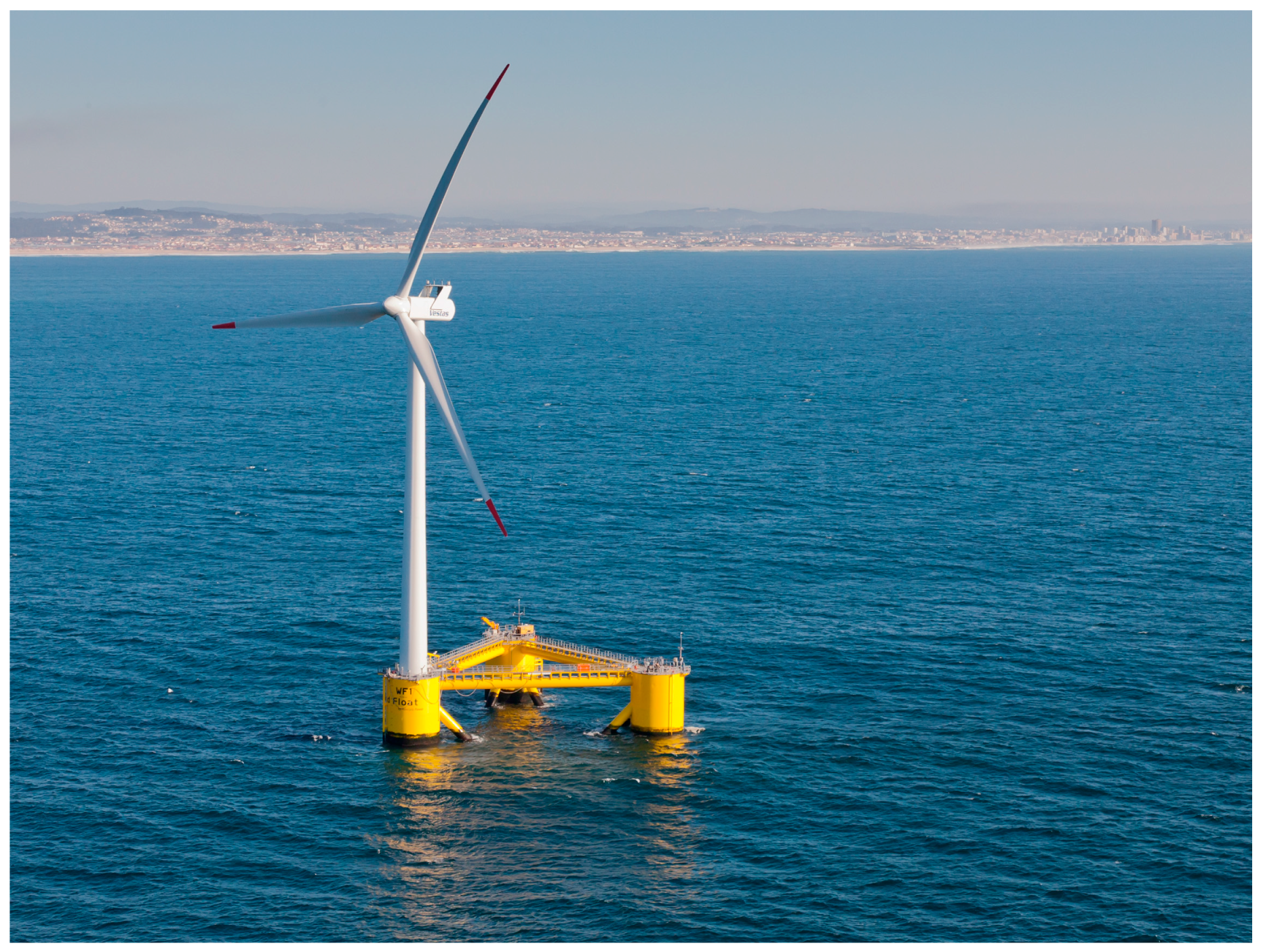
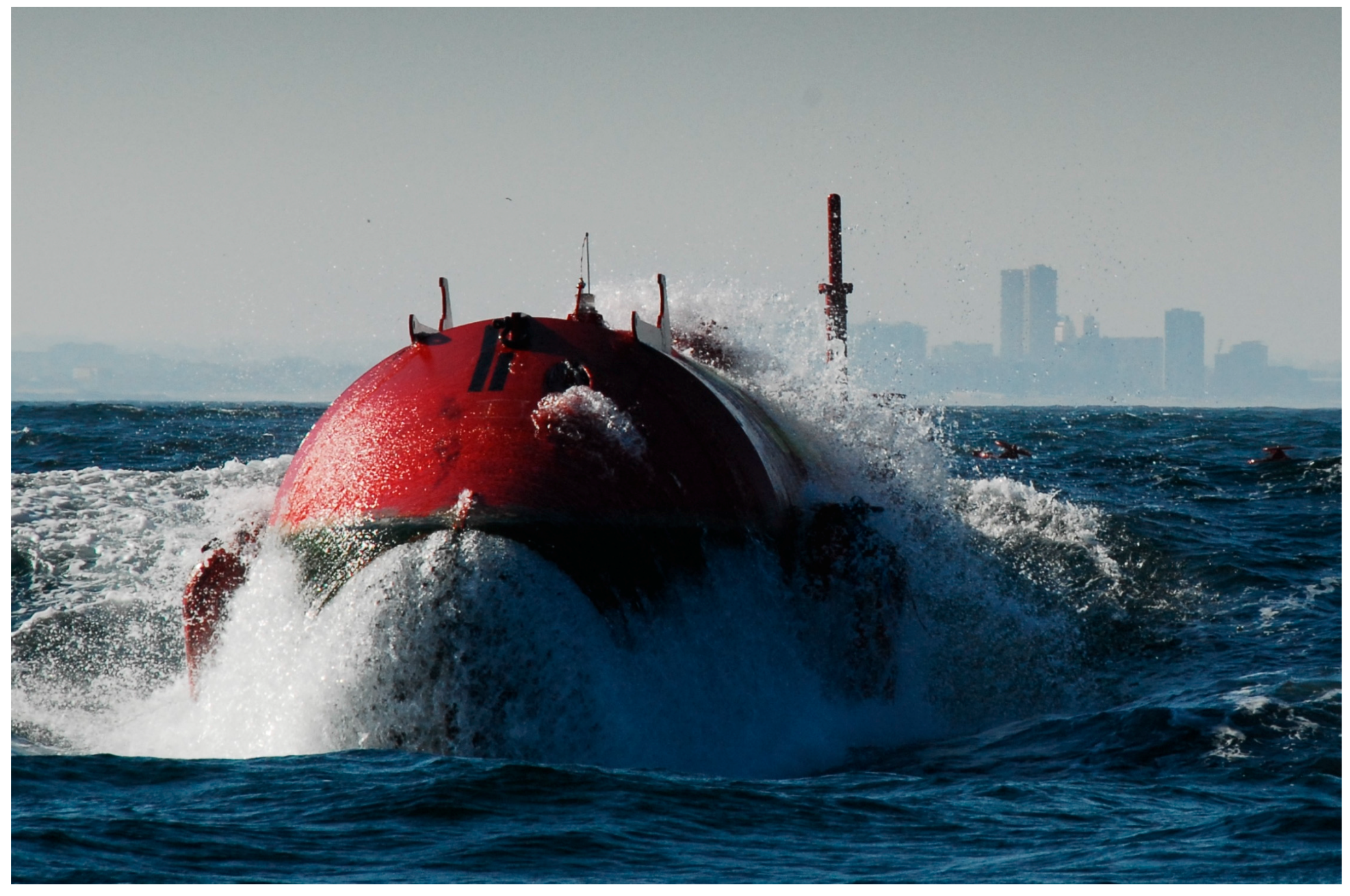
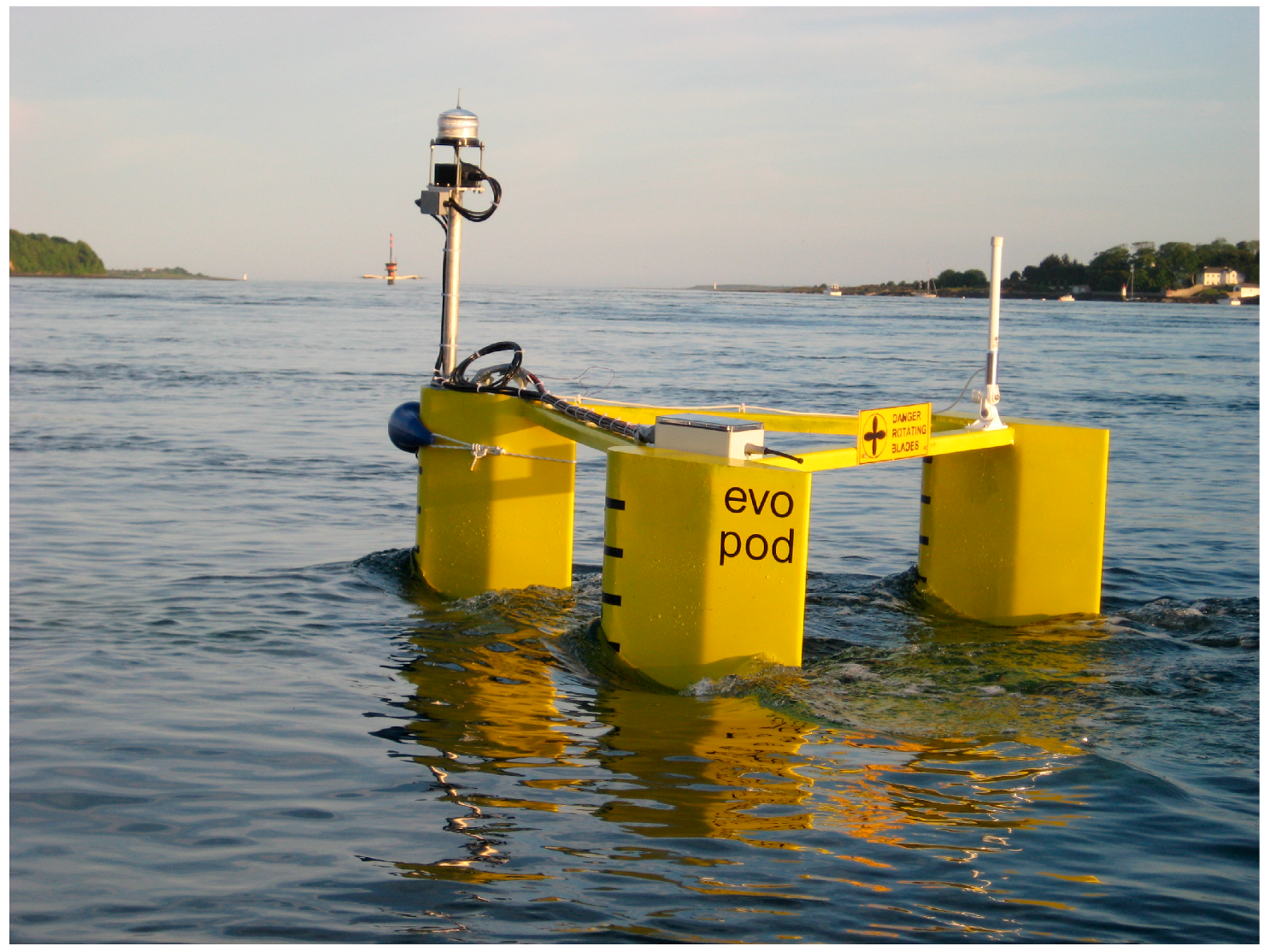
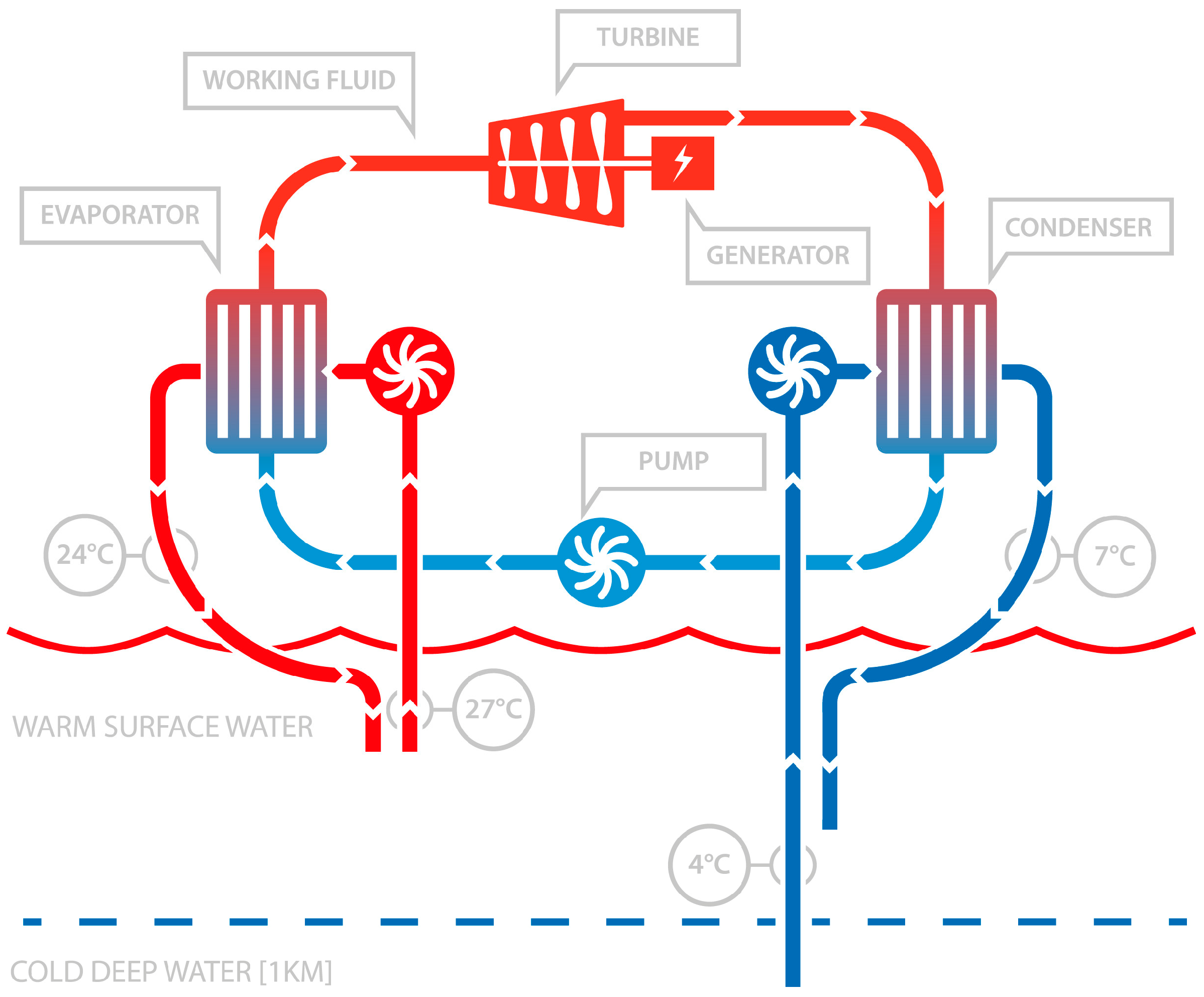
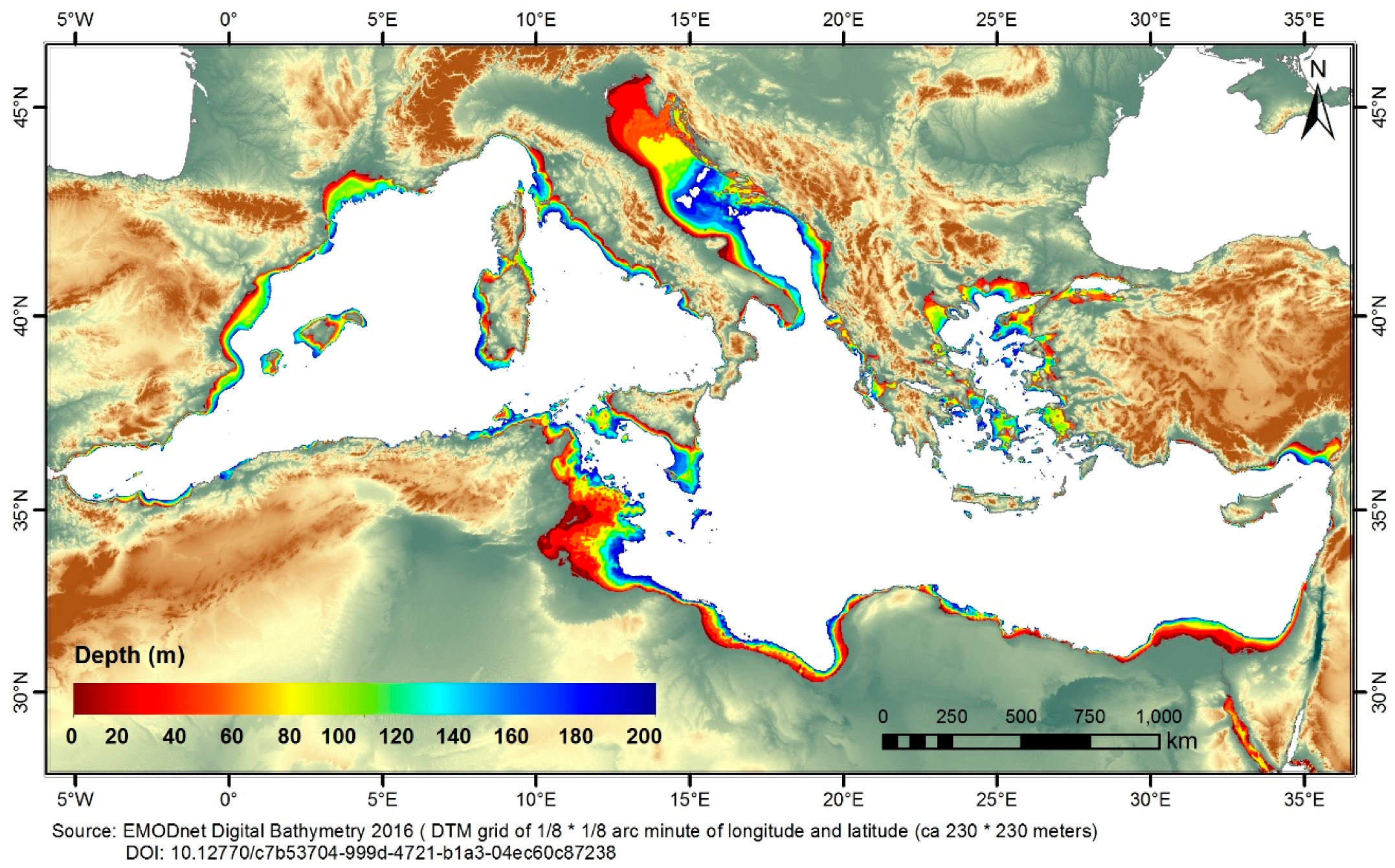
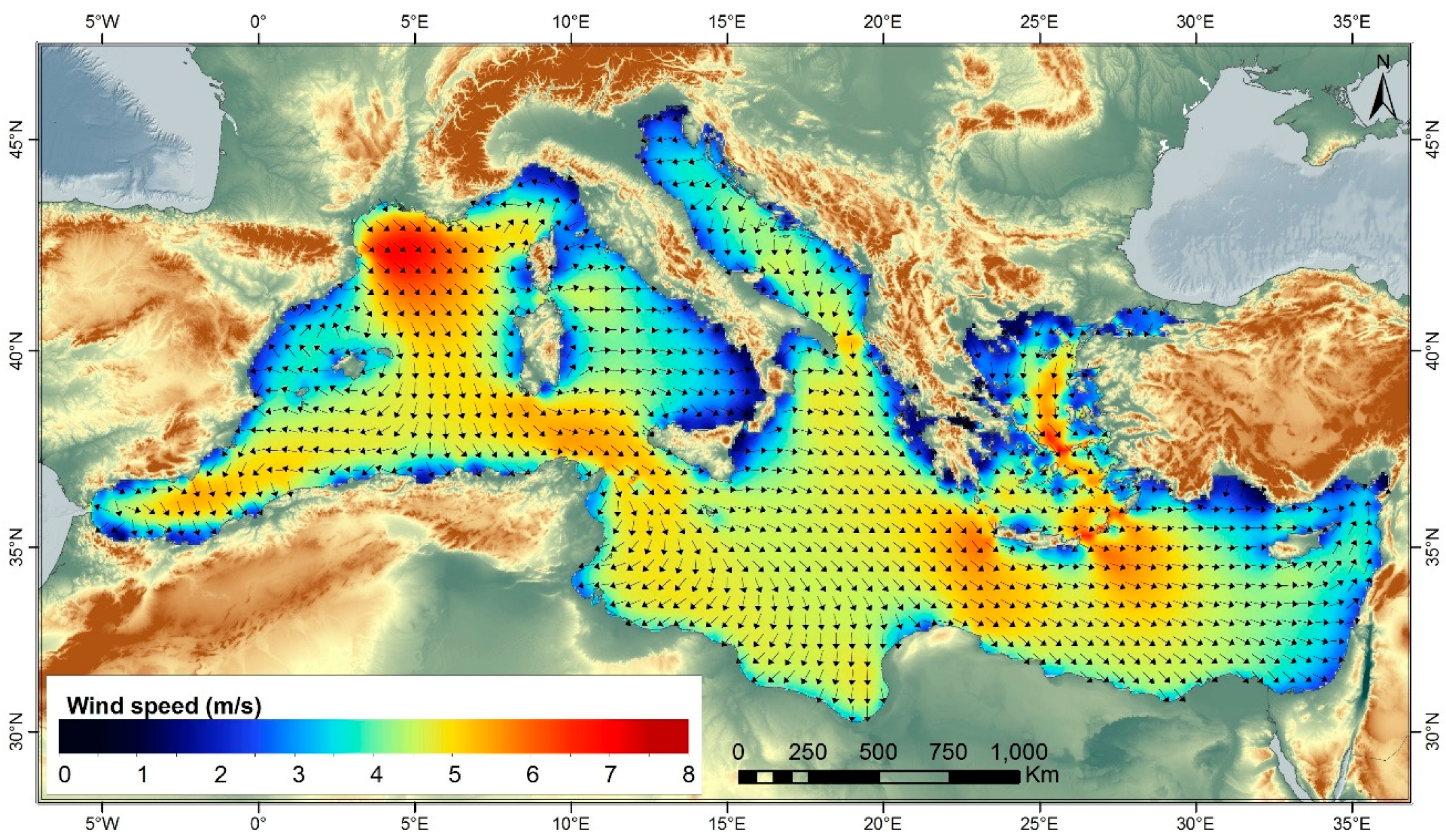
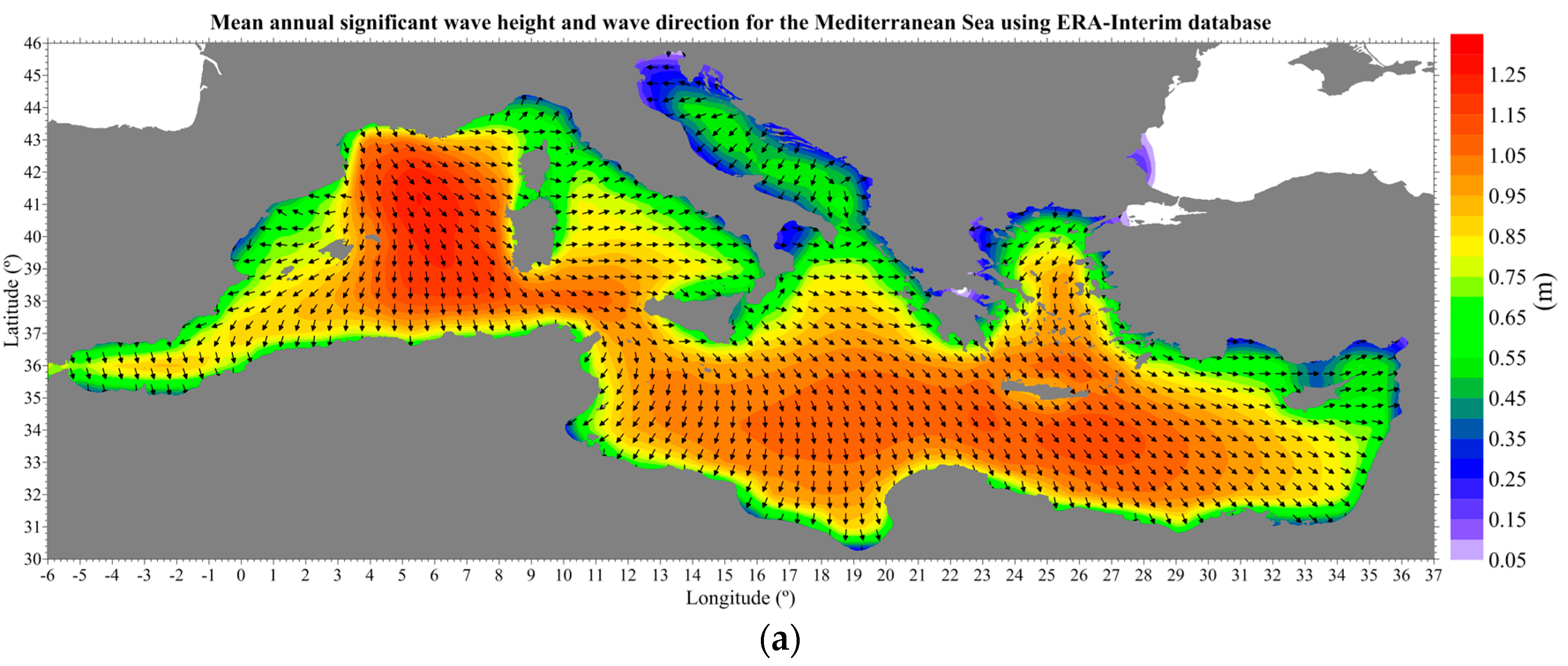
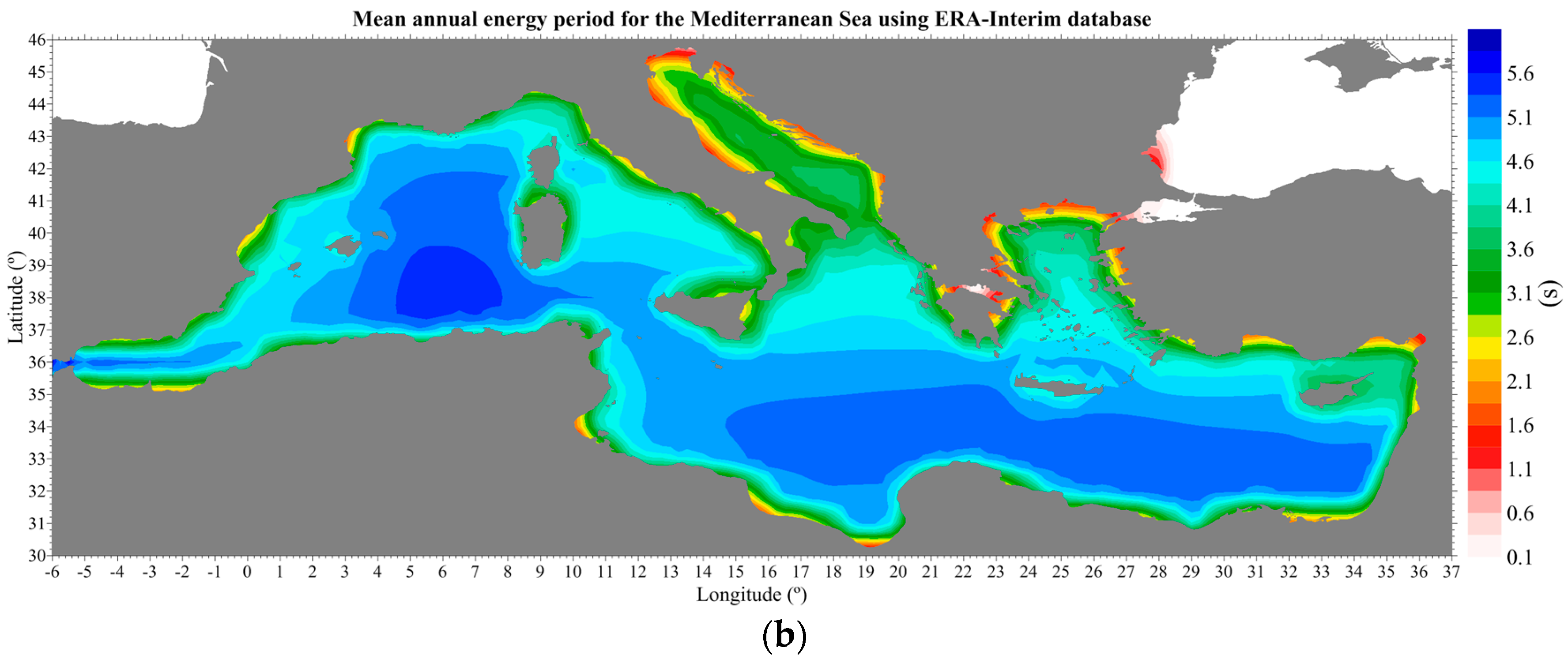
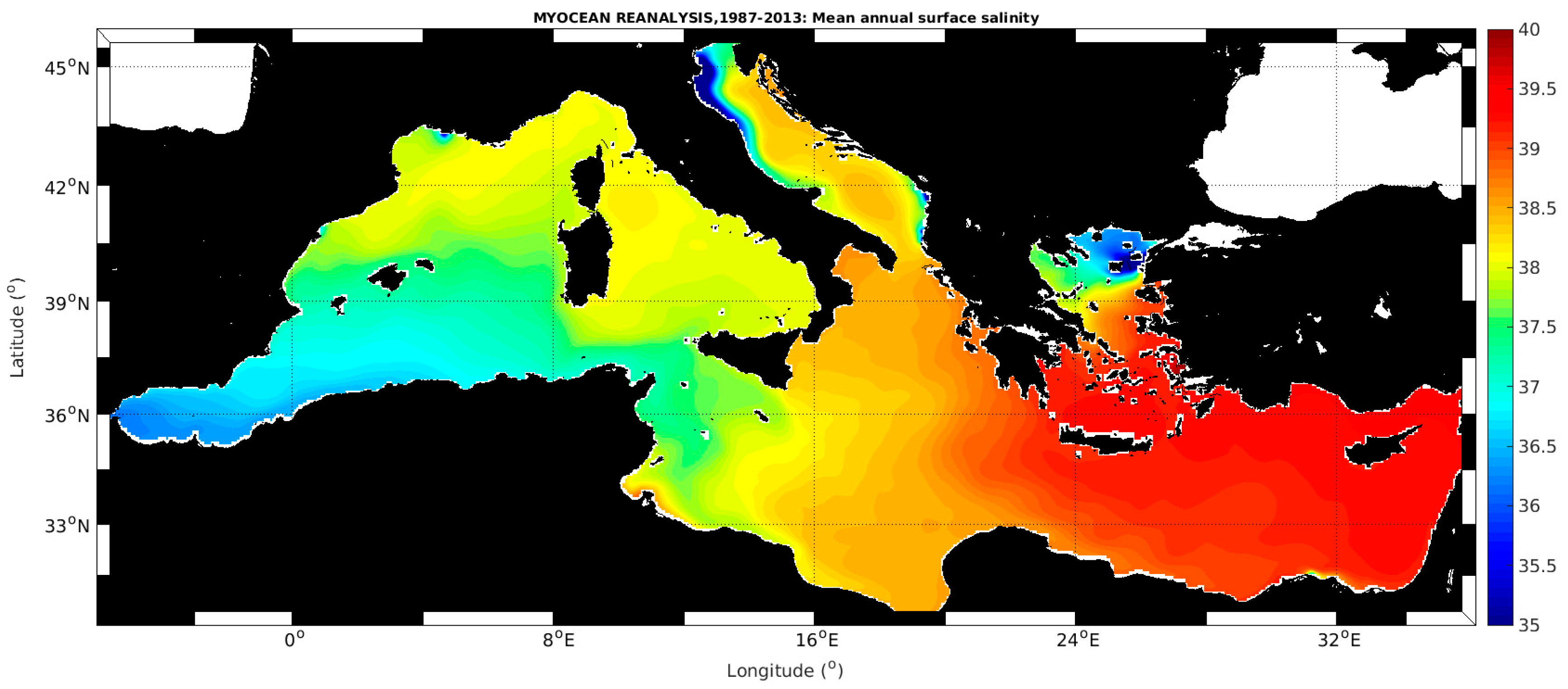
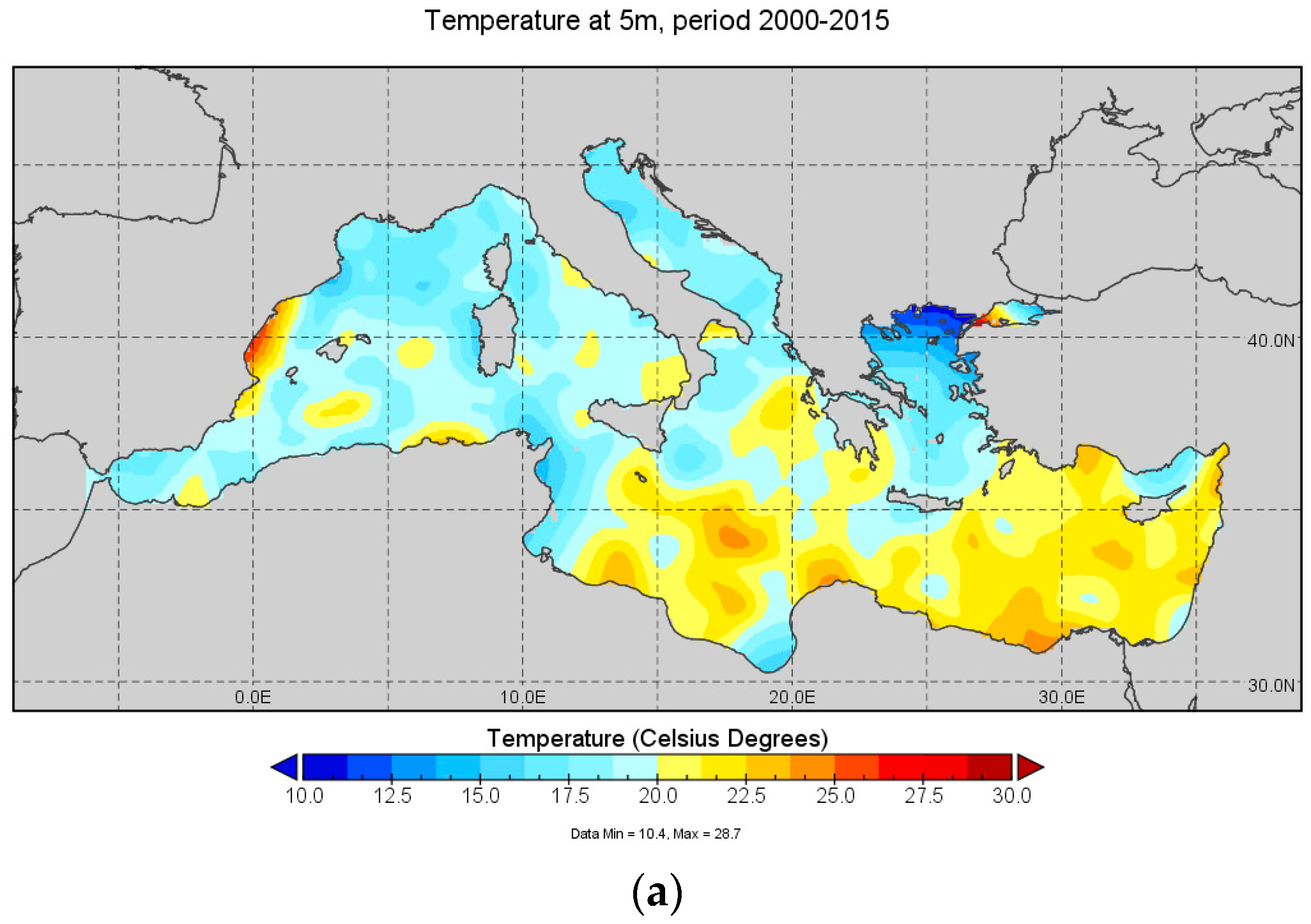
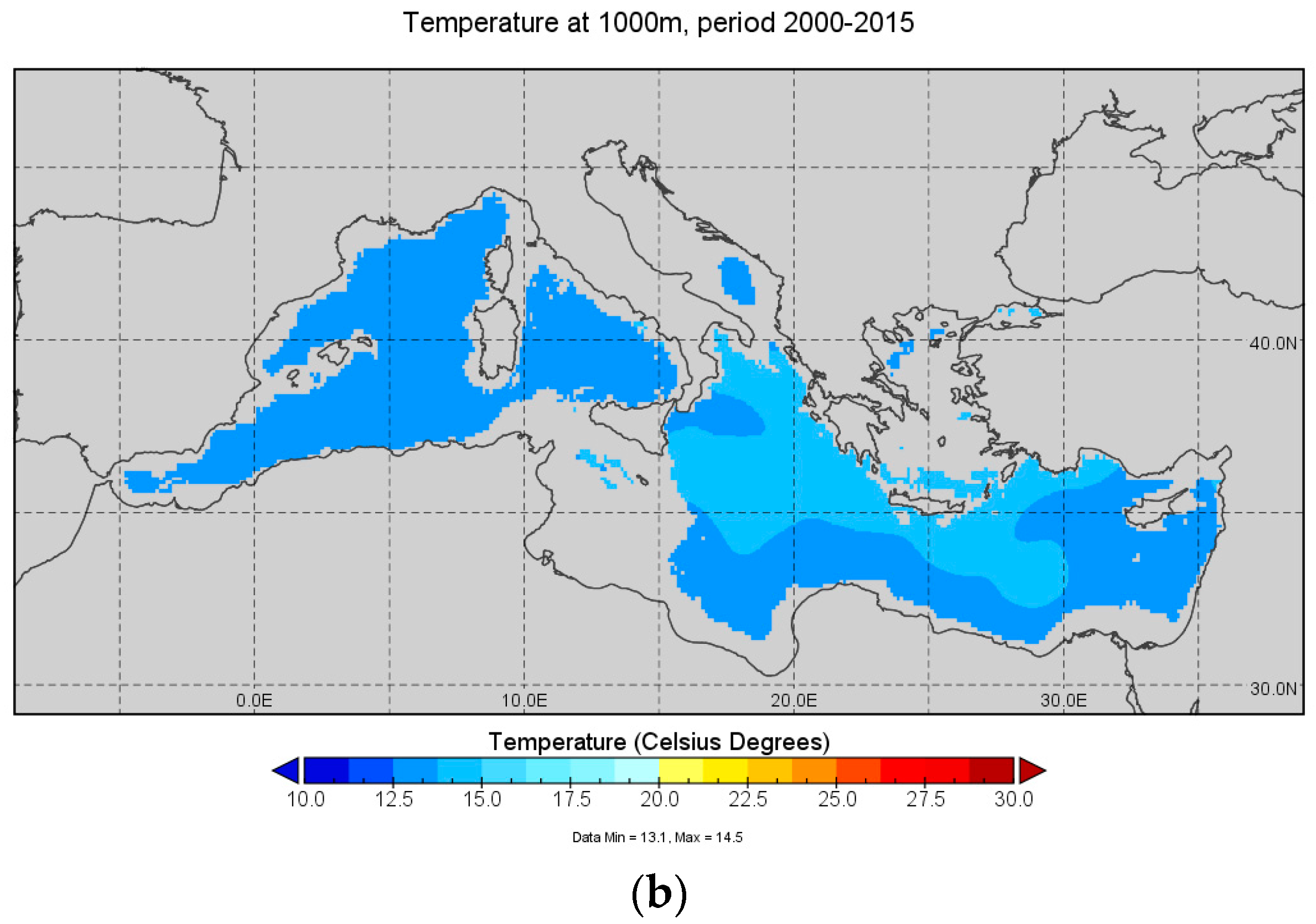
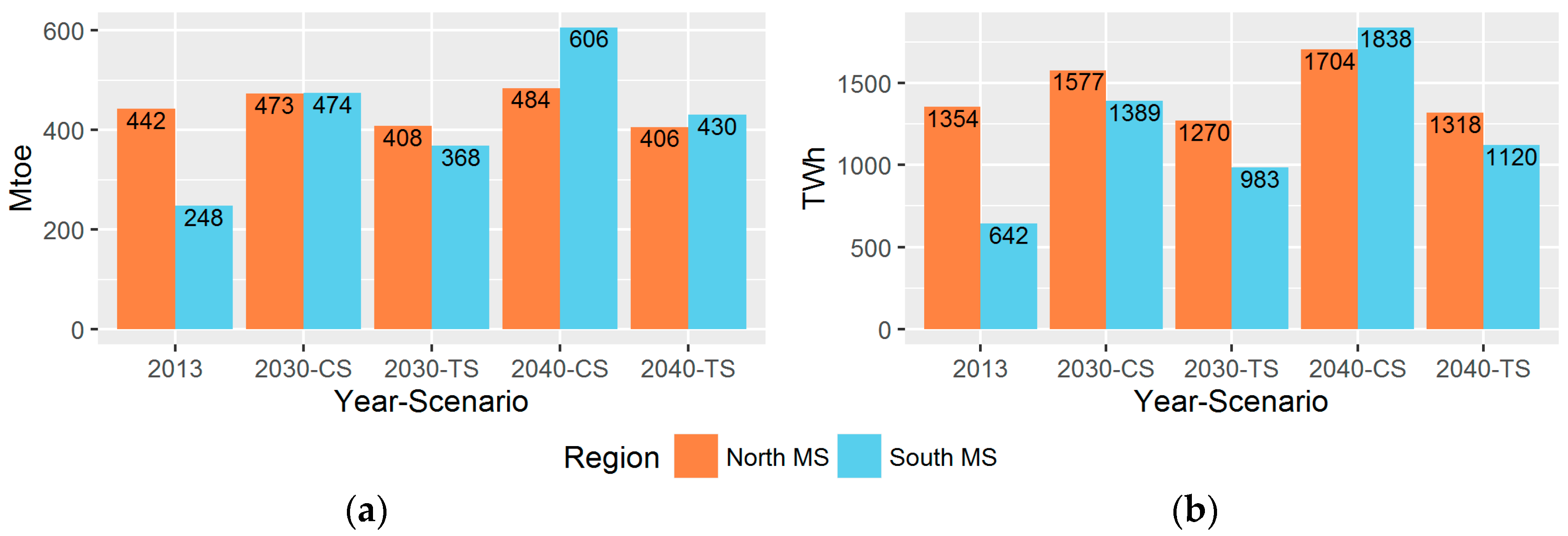
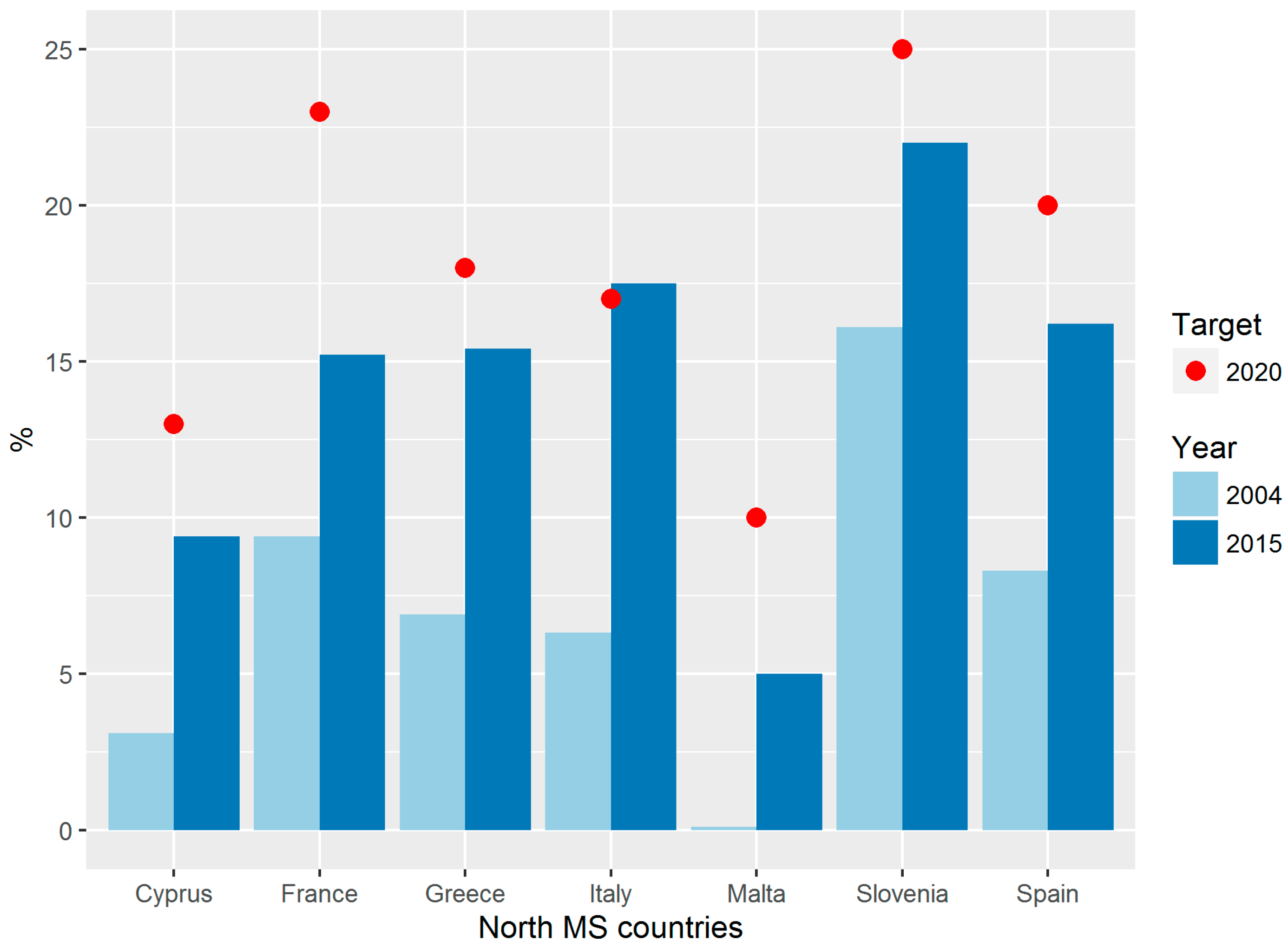
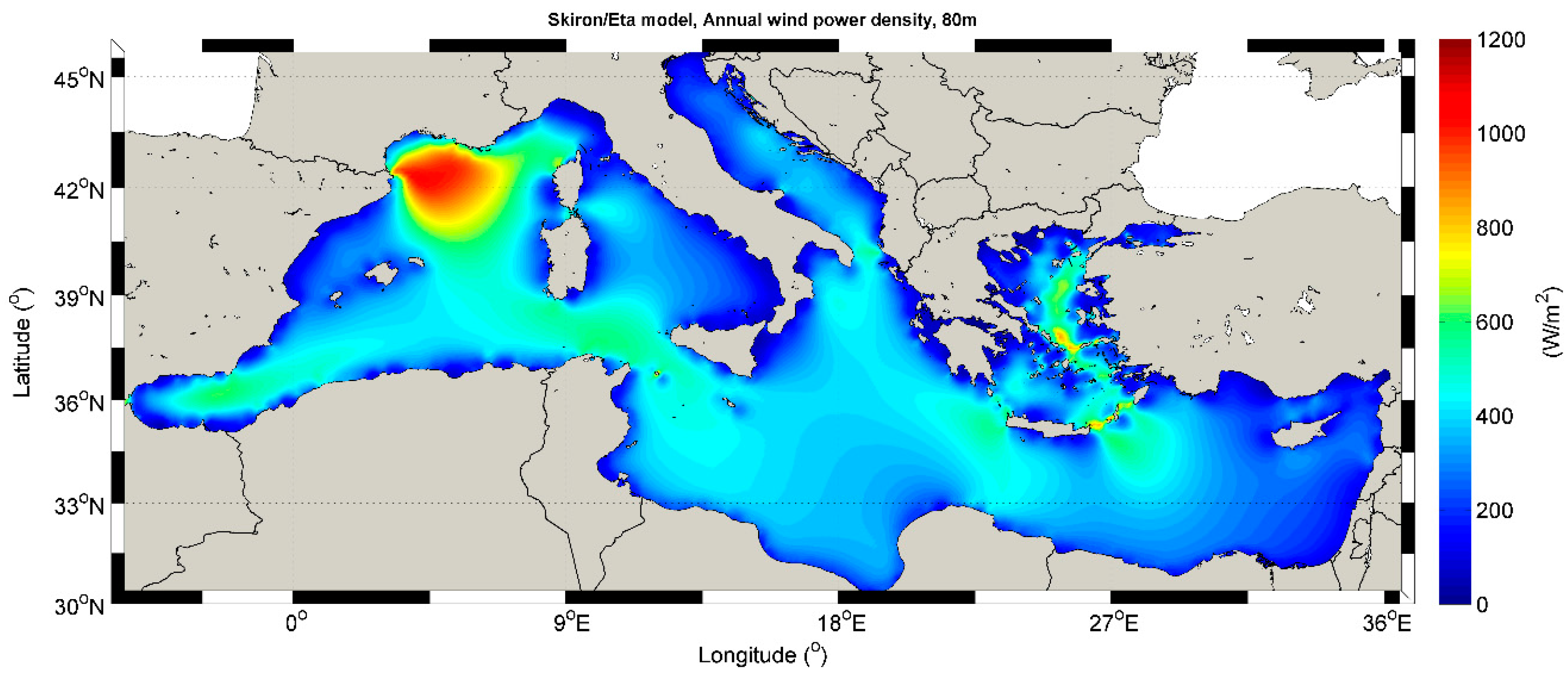
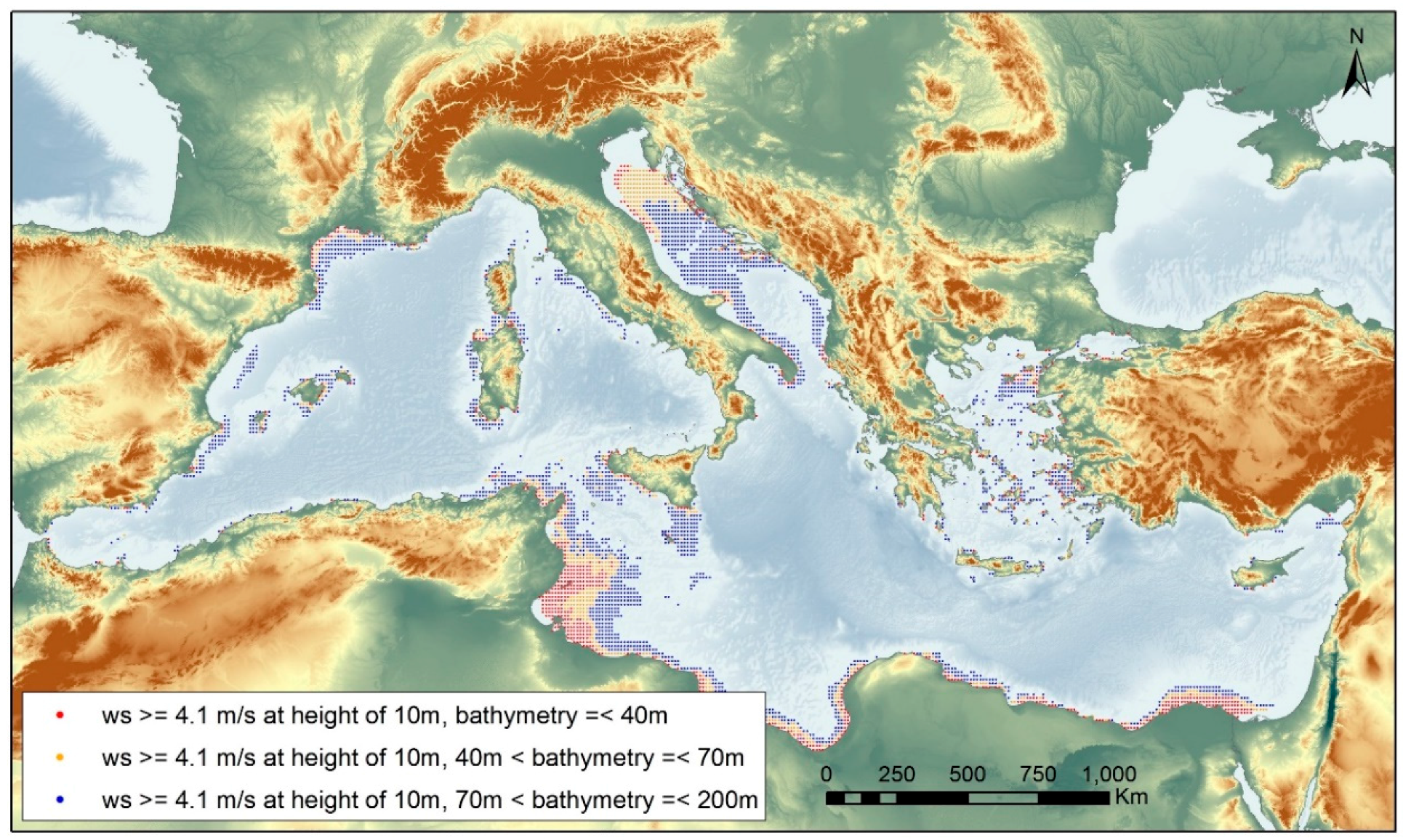
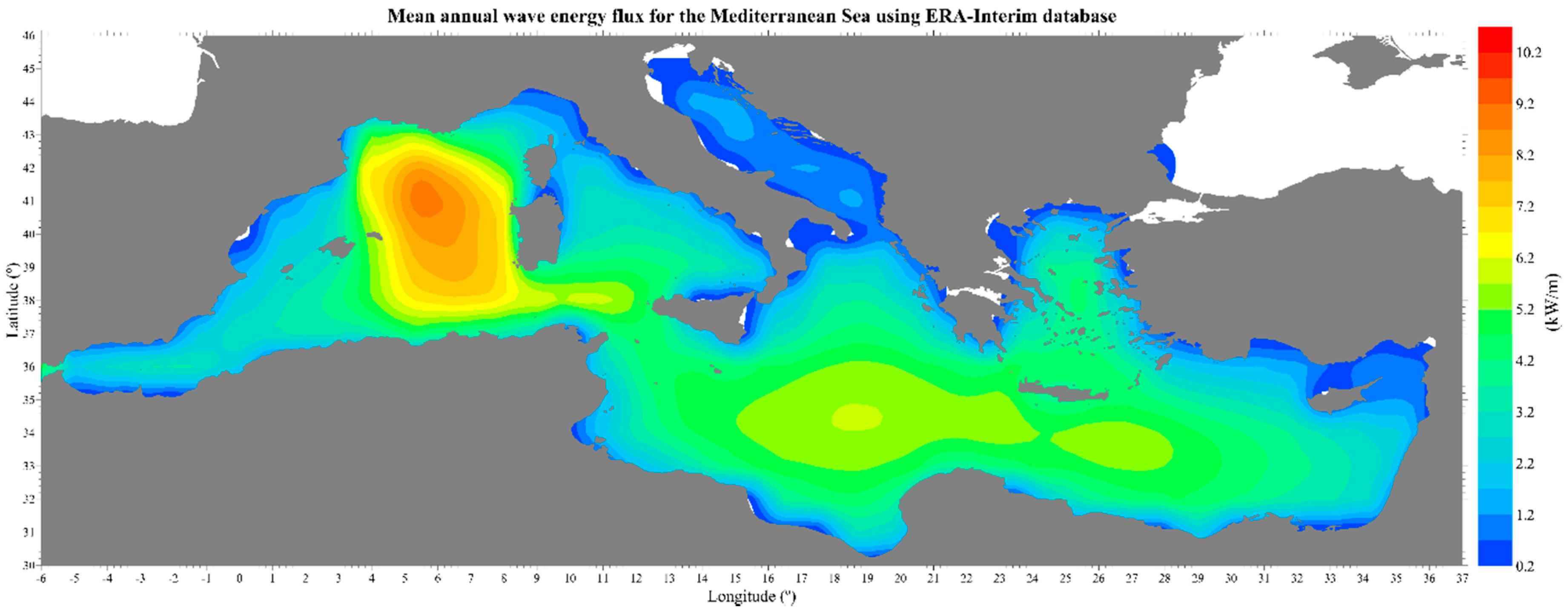
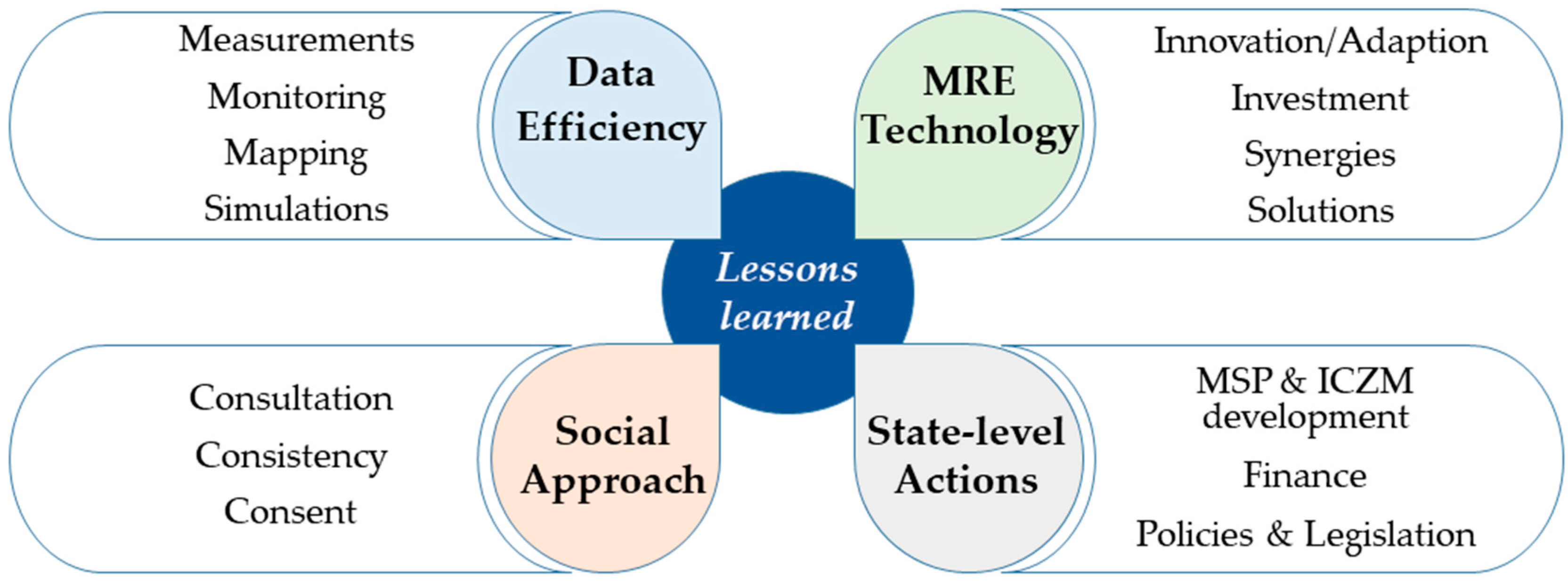
| EU-MED Country | Year | Total Net Production | Imports | Exports | Energy Supplied |
|---|---|---|---|---|---|
| Cyprus | 2014 | 4145 | - | - | 4145 |
| 2015 | 4312 | - | - | 4312 | |
| 2016 | 4634 | - | - | 4634 | |
| France | 2014 | 540,285 | 7873 | 75,063 | 465,138 |
| 2015 | 544,693 | 9961 | 74,024 | 473,754 | |
| 2016 | 531,147 | 20,790 | 61,406 | 483,798 | |
| Greece | 2014 | 46,702 | 9461 | 642 | 55,334 |
| 2015 | 47,806 | 11,081 | 1473 | 57,340 | |
| 2016 | 48,052 | 9833 | 1037 | 56,815 | |
| Italy | 2014 | 269,148 | 46,747 | 3031 | 310,535 |
| 2015 | 272,428 | 50,849 | 4471 | 316,897 | |
| 2016 | 275,649 | 43,181 | 6155 | 310,251 | |
| Malta | 2014 | 2137 | - | - | 2137 |
| 2015 | 1239 | - | - | 2293 | |
| 2016 | 848 | - | - | 2375 | |
| Spain | 2014 | 268,380 | 12,310 | 15,716 | 259,772 |
| 2015 | 269,750 | 14,956 | 15,089 | 265,097 | |
| 2016 | 264,356 | 21,845 | 14,178 | 267,204 | |
| Slovenia | 2014 | 16,486 | 7254 | 9997 | 13,380 |
| 2015 | 14,187 | 9045 | 9093 | 13,759 | |
| 2016 | 15,432 | 8358 | 9536 | 13,881 |
© 2017 by the authors. Licensee MDPI, Basel, Switzerland. This article is an open access article distributed under the terms and conditions of the Creative Commons Attribution (CC BY) license (http://creativecommons.org/licenses/by/4.0/).
Share and Cite
Soukissian, T.H.; Denaxa, D.; Karathanasi, F.; Prospathopoulos, A.; Sarantakos, K.; Iona, A.; Georgantas, K.; Mavrakos, S. Marine Renewable Energy in the Mediterranean Sea: Status and Perspectives. Energies 2017, 10, 1512. https://doi.org/10.3390/en10101512
Soukissian TH, Denaxa D, Karathanasi F, Prospathopoulos A, Sarantakos K, Iona A, Georgantas K, Mavrakos S. Marine Renewable Energy in the Mediterranean Sea: Status and Perspectives. Energies. 2017; 10(10):1512. https://doi.org/10.3390/en10101512
Chicago/Turabian StyleSoukissian, Takvor H., Dimitra Denaxa, Flora Karathanasi, Aristides Prospathopoulos, Konstantinos Sarantakos, Athanasia Iona, Konstantinos Georgantas, and Spyridon Mavrakos. 2017. "Marine Renewable Energy in the Mediterranean Sea: Status and Perspectives" Energies 10, no. 10: 1512. https://doi.org/10.3390/en10101512
APA StyleSoukissian, T. H., Denaxa, D., Karathanasi, F., Prospathopoulos, A., Sarantakos, K., Iona, A., Georgantas, K., & Mavrakos, S. (2017). Marine Renewable Energy in the Mediterranean Sea: Status and Perspectives. Energies, 10(10), 1512. https://doi.org/10.3390/en10101512








